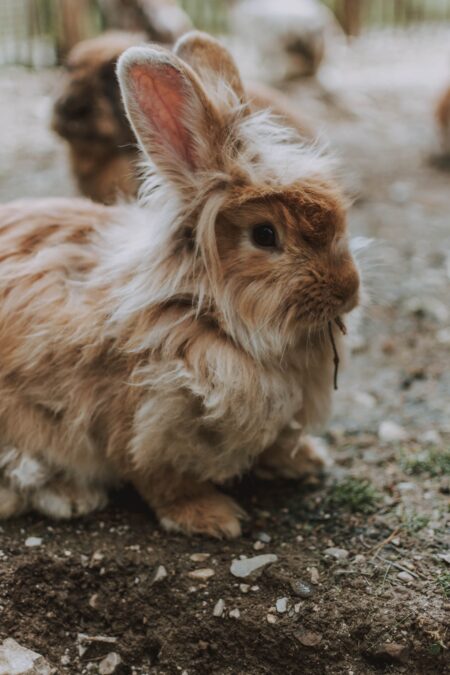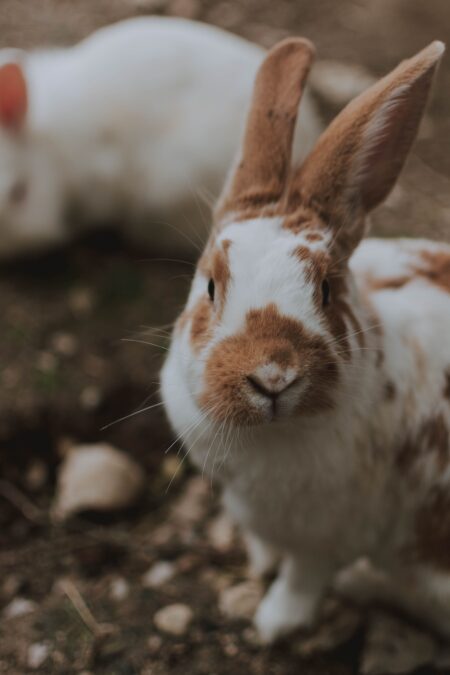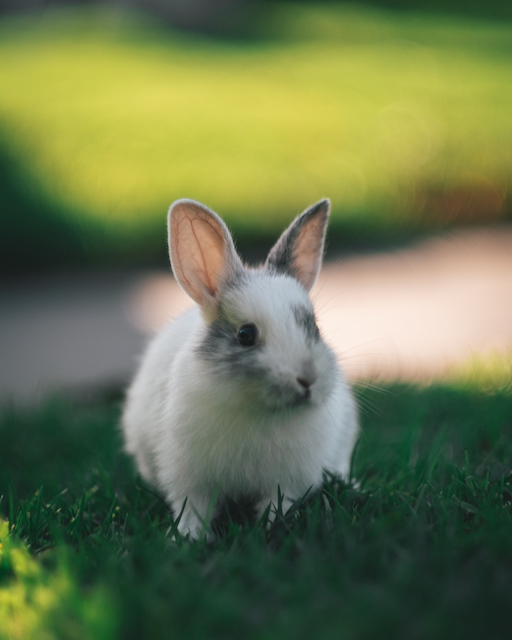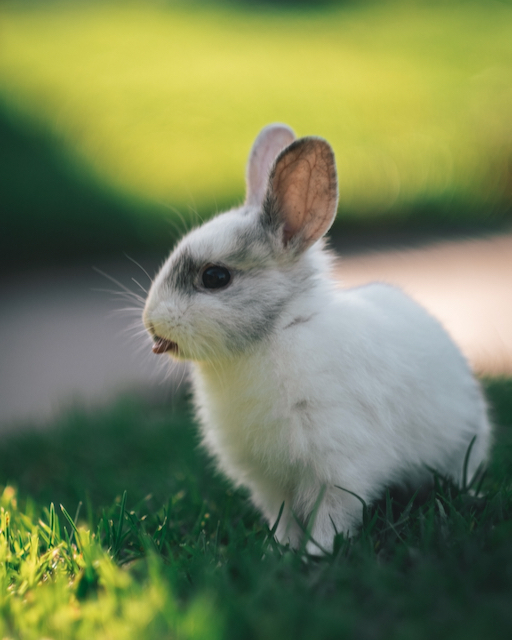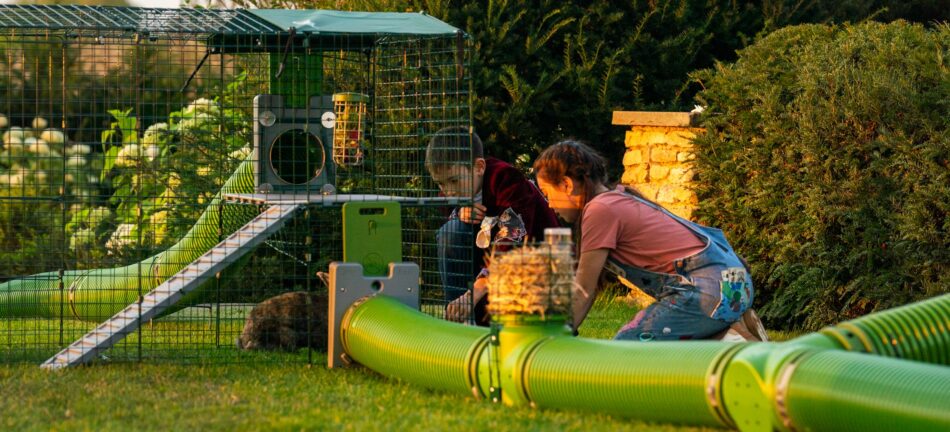
Thankfully, rabbits and flystrike aren’t a common pairing when bunnies are well cared for. Healthy rabbits that can groom themselves and have a clean environment are not easily affected by flystrike. But as prey animals, rabbits are very good at masking their discomfort – so it’s important to know what flystrike is, how to prevent it, and how to treat it.
What is flystrike?
Flystrike, also known as myiasis, is a condition where animals that live outdoors become infested with fly larvae (maggots). In rabbits, flystrike begins when Lucilia sericata (green bottle fly) lays eggs on their skin. When the maggots hatch, they take up residence on your rabbit – eating through the skin and eventually invading the deeper tissue beneath. As awful as this condition is, it’s not common in healthy bunnies. The majority of rabbits that suffer from flystrike are:
- Those that cannot groom themselves due to obesity or other illness
- Living in unsanitary housing conditions
- Soiled from urine or faeces, or wounded
If your rabbit’s coat becomes overly dirty (caked on droppings, urine-soaked, or constantly damp from the weather) or their living conditions become so soiled that droves of flies are drawn to them, they are at risk of flystrike. Flies are part of living outdoors and small numbers of these flying pests are not usually cause for alarm. But, when flies are attracted to the dirty, smelly coat of a rabbit in less-than-ideal conditions, trouble sets in.
Flystrike is most common during the summer months when flies are the most active. Warmer temperatures are hospitable for maggots, and flies are in abundance this time of year. And, with more rabbits laying in the cool grass or shade during the heat of the day, flies can easily seek them out. Bringing your rabbit indoors during the hottest part of the day may help abate the nuisance from flies.
Do indoor rabbits get flystrike?
Indoor rabbits can get flystrike, but it is much less common than if they lived outdoors. The same conditions apply for indoor rabbits to become affected by flystrike, and it’s less likely that those living indoors would have unsanitary coats or living conditions. And, houses tend to have fewer flies inside than the outside world.
Keeping your home clean with indoor rabbits is essential to avoiding flies. If you’re bringing your outdoor rabbits inside for brief periods during the day, make sure you’re not bringing flies in with them. Clean their indoor spaces daily to deter flies from accumulating.
6 signs & symptoms of flystrike in rabbits
Flystrike can occur rapidly, as maggots can hatch within mere hours of eggs being laid. Maggots seek out a food source as soon as they hatch, meaning your rabbit is in imminent danger of becoming a host for them. Bunnies may exhibit any of the following signs if they’re suffering from flystrike, so it’s important to perform regular rabbit health checks to evaluate their health.
1. Presence of maggots
The first symptom of flystrike is the presence of maggots. Fly larvae start out small and are worm-like in appearance. Flies lay their eggs on the part of the animal they are most drawn to. In the case of rabbits, this will usually be around the tail where urine and faeces are most likely to be present.
2. Lethargy
Your rabbit may appear listless or dull when they’re in pain. Flystrike causes extreme discomfort, so your bunny is likely to be less active and will be hesitant to move in most cases. Lethargic rabbits may also spend more time inside of their hutch.
3. Loss of appetite
Most animals (rabbits included) will be off of their feed when they aren’t feeling well. If your rabbit isn’t eating or drinking, there’s a good chance there’s something going on with them. Flystrike can cause a weakened or dehydrated rabbit to go downhill rapidly.
4. Increased digging
Agitated rabbits in pain may dig more in an effort to relieve their discomfort. Look for signs of your rabbits digging in corners in particular. Claw marks on the inside of hutches, outside in the run, or in bedding can be telling of a rabbit in pain.
5. Odour from enclosure
As you can imagine, flystrike causes a foul odour. The smell of the decaying flesh that the maggots leave in their wake is not a subtle sign. This sign usually occurs as flystrike progresses to a dire level.
6. Shock
The final stage of flystrike is shock. Shock sets in when a rabbit’s body is overwhelmed by pain, infection, or external stressors. Flystrike brings all of these conditions, making it very dangerous for rabbits. Symptoms of shock include:
- Rapid breathing
- Pale mucous membranes (eyes, gums)
- Seizures
- Unconsciousness or collapse
- Death
If you notice any maggots on your rabbit, or any of the above signs or symptoms, be sure to contact your bunny’s veterinarian right away. Prompt treatment is necessary to combat flystrike.

Which rabbit breeds are more prone to flystrike?
Any breed of rabbit can fall victim to flystrike, but some may be more susceptible than others depending on environmental factors. Lionheads or Angora rabbits have longer coats than other breeds that can become soiled quickly without regular grooming. Large breeds like the Flemish Giant are more prone to obesity due to their size, and overweight rabbits can’t groom themselves as thoroughly as bunnies that are the ideal weight.
How to prevent rabbit flystrike
Keeping your rabbit’s home clean is one of the most important and effective ways to prevent flystrike. Cleaning your rabbit’s hutch and refreshing their bedding daily in the summer is essential to combating flies. The Eglu Go Plastic Rabbit Hutch by Omlet can be thoroughly cleaned in just a few minutes each day, and has ample ventilation to prevent odours from building up. The expandable attached run gives rabbits plenty of room to run and lounge, spreading out their droppings to further deter flies from gathering.
For even more space to escape flies, our Zippi Rabbit Tunnel System can be connected to your hutch and rabbit playpen to create a larger area. You can also add platforms to playpens to encourage more exercise and prevent your rabbits from becoming overweight. Combined with a balanced bunny diet, Zippi Rabbit Platforms will help your furry family members stay in tip-top shape.
How to treat rabbit flystrike
Flystrike is a medical emergency and you should contact your rabbit’s veterinarian right away to prevent irreversible damage. Do not attempt to treat or remove burrowed maggots yourself, as pieces can break off inside of your rabbit and cause infection. Rabbits with flystrike will need prescription antibiotics and pain medication to make a full recovery.
Omlet and caring for your rabbit
Omlet’s rabbit products help keep your rabbits healthy and happy. Our easy-to-clean designs were created to help owners spend less time cleaning and more time playing with their pets. The Eglu Go Rabbit Hutch, Zippi Rabbit Platforms, and Zippi Tunnel System are all easy to keep clean, and encourage more movement from your bunnies to promote overall health. Combat flystrike and other dangerous conditions when you house your rabbit in expertly crafted setups by Omlet.
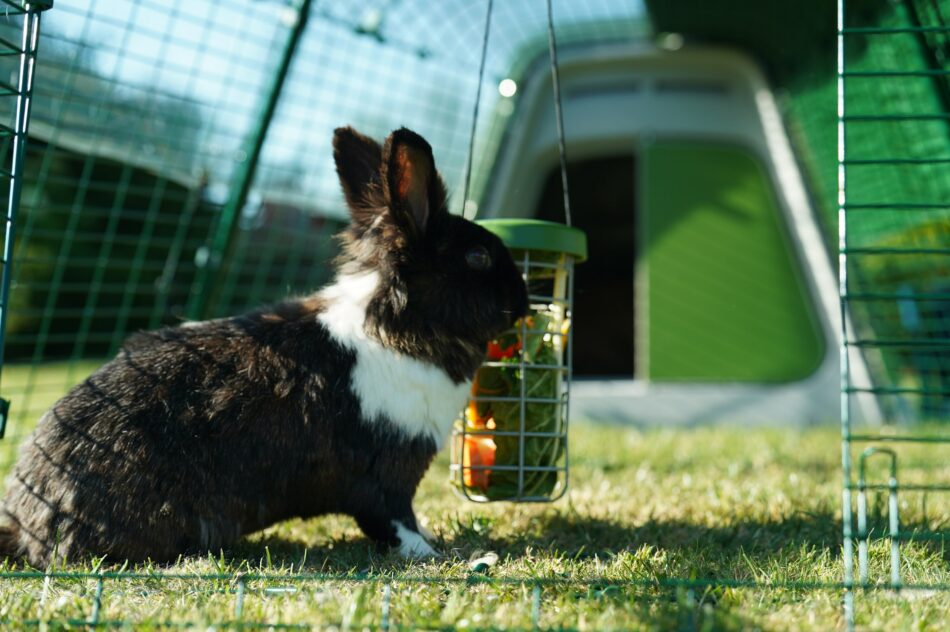

This entry was posted in Rabbits
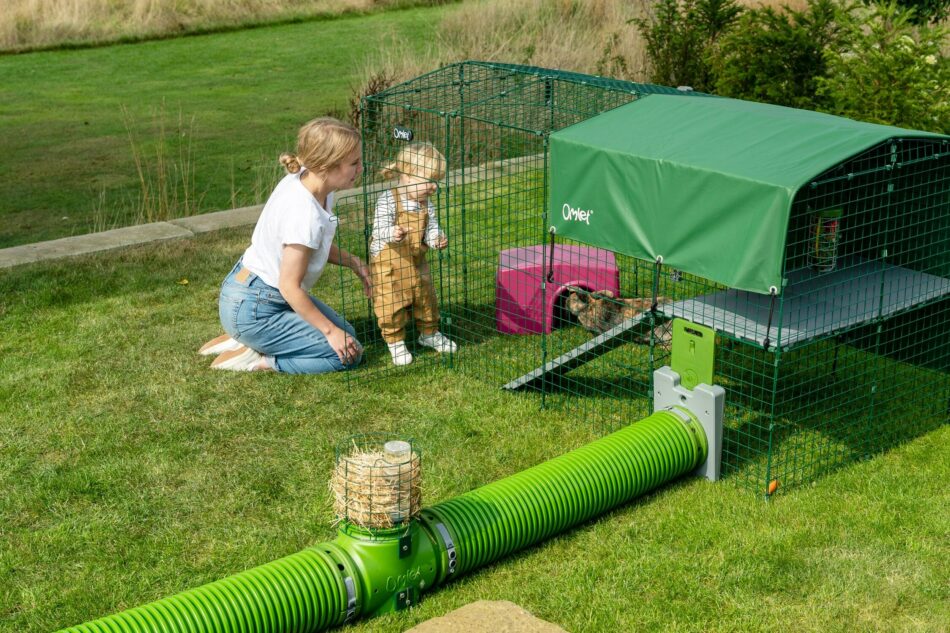
With so many different species of animals to choose from, many parents find themselves asking: Are rabbits good pets for children? The short answer is yes, as long as there is mutual understanding between rabbits and their owners. Bunnies can be wonderful pets, full of personality and adorable antics when they’re able to exhibit their natural behaviours. With complete rabbit setups from Omlet, your children will begin bonding with their bunny right away, and for years to come.
Why rabbits can make great pets for children
Rabbits are intelligent, sociable, and relatively low-maintenance. These attributes are some of the reasons why bunnies make great first pets for children. Rabbits can be housed indoors or outdoors, but are happiest when they are provided with as much space as possible. In the wild, rabbits live in extensive underground burrows and tunnels – and their domesticated counterparts share the same desire to navigate these structures.
Omlet’s Zippi Rabbit Tunnel System simulates the tunnels and burrows that rabbits would construct in the wild. Combined with our Zippi Rabbit Runs and Platforms, your bunnies will be scurrying, bounding, and exploring just as they would naturally. And, you can let your children pick out rabbit run accessories to further customize their pets’ space.
Our Eglu Go Rabbit Hutches are the perfect size bunny abodes for both pets and children. The easy-to-clean structure will enable your kids to clean their pet’s home with ease, and will keep your yard smelling fresh. And, with optional wheels and handles, our Eglu Go hutches and attached runs can be manoeuvred around the yard with ease.
Creating a rabbit’s ideal space is just one of the many ways to bond with your bunny. Our rabbit products are designed to bring you and your bunny closer than ever. With the right setup and some quality time, your family will have forged a relationship with your rabbit that will last a lifetime.
Rabbits and children: 3 things to consider
While it’s true that rabbits can make excellent first pets, it’s important to set realistic expectations for both your bunny and your children. Make sure your kids are prepared for the responsibilities associated with owning a rabbit, and are familiar with bunny behaviours and body language.
1. Bunnies should have buddies
Rabbits do best in groups of two or more. In the wild, colonies of rabbits can consist of anywhere from two to dozens of bunnies. A lonely rabbit can act out or display attention-seeking behaviours. Adopting a pair of bonded rabbits is the best way to start off on the right foot, but you can also adopt young rabbits to raise together. Make sure that any males are neutered – even if you only keep males. Intact male rabbits can become territorial when kept together, and unaltered males kept with females will result in unwanted litters. Intact females can usually be kept together with no issues.
2. Rabbits are a long-term commitment
The life expectancy of rabbits is 8-12 years, so they can be a long-term commitment. Make sure plans are in place for when your children and rabbits are older. Will they take their pets with them when they move out? Do you have younger children to care for the rabbits once their siblings are grown? Or, are you willing to continue caring for the rabbits yourself?
The Eglu Go Plastic Rabbit Hutch is the only home you’ll need to buy for your rabbits. Designed to last a lifetime, our rugged construction of heavy-duty plastic and rot-free materials will stand the test of time. It should be noted that only rabbits over the age of 6 weeks old should be housed outdoors. Younger rabbits have more trouble regulating their body temperature, and will fare better when gradually introduced to outdoor temperatures. This also applies to older rabbits that were raised indoors. Introduce rabbits to life outdoors in small increments over the course of a couple of weeks to make the transition as smooth as possible.
3. Bunnies need boundaries
Any rabbit can be housed outdoors, and most fare better when they’re allowed to live outside. Not only does it mimic their natural habitat, but being outside gives them reprieve from the hustle and bustle of a household. Understanding your bunny’s body language will clue you in on how they’re doing in their surroundings. And, as with most pets, giving your rabbits as much space as possible will help ensure they’re healthy and happy as possible.
Omlet’s Zippi Rabbit Playpens help create boundaries for your bunnies in any setting. Perfect for designated spaces outdoors, or as indoor playpens for a change of scenery, our Zippi Playpens are easy to move and are predator-resistant for peace of mind.
The attached run of the Eglu Go Rabbit Hutch can also be extended to up to 12 feet long, giving your rabbits plenty of room to roam.
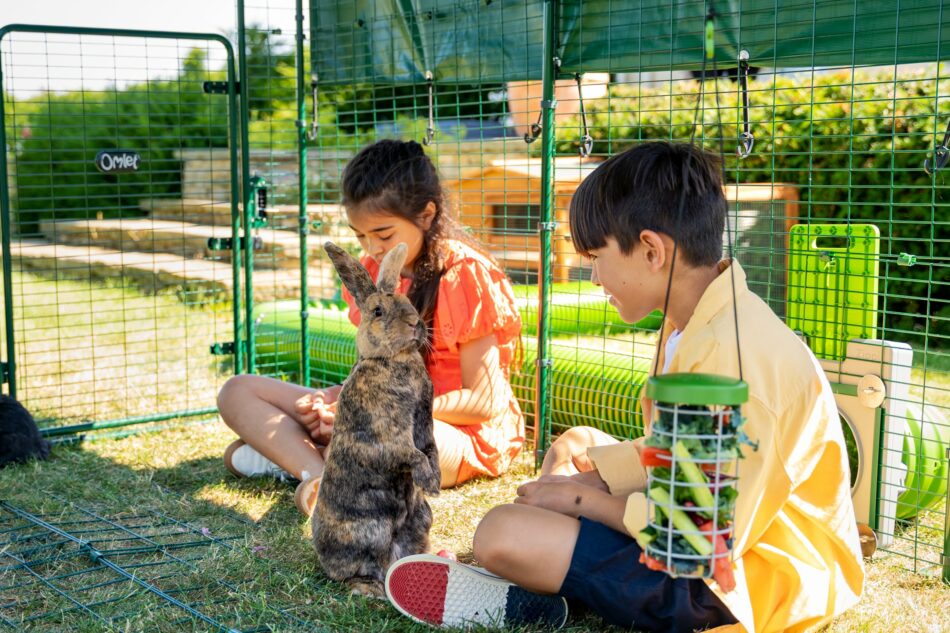
Best rabbit breeds for children
Once you’ve decided that rabbits will be a good fit for your family, it’s time to decide on the breeds of bunnies you’ll want to keep. Choosing the right rabbits largely comes down to personal preference and your space or climate.
For example, breeds like the Lionhead rabbit are excellent for children due to their docile nature, but may not be suited to life outdoors in hot or humid weather. Californians are considered to be a hardy breed in all climates, as well as being known for their sweet temperaments. Other breeds that are good for children include:
Flemish Giants also make excellent pets, but due to their size require plenty of space.
Omlet and your pet rabbit
Omlet aims for owners to raise their rabbit-readiness status quickly and easily. Our line of bunny products like the Eglu Go Rabbit Hutch, Zippi Rabbit Playpens and Platforms, and Zippi Rabbit Tunnel System are all designed to make rabbit ownership truly remarkable. At the end of the day, parents have to ensure that their children are caring for their pets properly, but with Omlet, helping your children with chores becomes a joy. With Omlet, you’ll bring your entire family closer together – both with each other and with your pets.
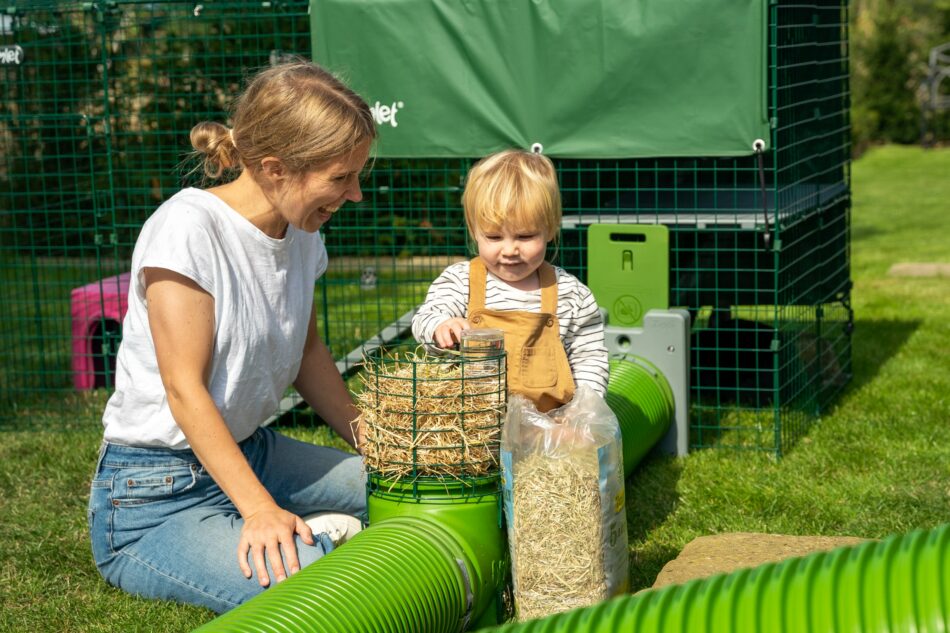

This entry was posted in Rabbits

Rabbits make excellent pets for owners of all ages. Once you have all of the rabbit care essentials you need, bunnies are easy to take care of. They can be litterbox trained similarly to cats, are capable of bonding with their owners, and are a joy to watch. Like all pets, bunnies need love, attention, and proper housing to live a healthy and happy life.
Omlet has designed products that meet your rabbit’s needs, while making caring for them as easy as possible for you. Our line of rabbit products set you up for success with your bunny from the very beginning, and for the years to come. Let’s explore what life with rabbit products by Omlet looks like.
The perfect rabbit hutch
Does the perfect rabbit hutch exist? We think so! The Eglu Go Rabbit Hutch checks all the boxes for both bunnies and their keepers. Here are some reasons why:
- The dual-insulated walls of the Eglu Go Rabbit Hutch keep your bunny cool in the summer and warm in the winter
- All plastic construction and a removable bedding tray make cleaning a breeze
- An easy-access rear panel and pivoting hutch door keeps your rabbit accessible
- The attached run has anti-dig flooring and can be expanded for even more space
Plastic vs wooden rabbit hutches
Your rabbit’s hutch is where they will spend the majority of their time, so it’s important to choose the right one. There are a lot of rabbit hutch options out there, but a quality rabbit hutch should be safe, well-constructed, and built to last for years.
Plastic rabbit hutches are far superior to traditional wooden hutches. Most notably, rabbits have a natural desire to chew in order to keep their ever-growing teeth trimmed short. But, this spells trouble for wooden hutches, as they quickly become a chew toy for your bunny. Over time, chewing weakens the structural integrity of wooden hutches, which makes your rabbit vulnerable to unwanted visits from predators.
Omlet’s Eglu Go Rabbit Hutch will never succumb to rot like wooden hutches, and will never need touch-up paint or re-roofing. Plastic is not appetizing to rabbits, so you won’t have to worry about your bunny gnawing on their house. And unlike wooden hutch wire, our heavy-duty wire panels that make up the attached run are complete with mesh flooring to prevent your bunny from burrowing out of their enclosure.
Accessorize your rabbit’s home
Rabbits are extremely active animals. From wild hares to pet bunnies, rabbits need exercise and enrichment to stay physically and mentally fit. They need plenty of space to run, hop, and scurry, so you’ll need to give them as much room as possible.
Our Zippi Rabbit Tunnel System can extend your rabbit’s domain while fostering their natural burrowing behaviour. Zippi Tunnels can be attached to any type of wooden hutch or wire run, and have multiple customization options. Expand and change your rabbit’s Zippi Tunnel System at any time with connection pieces, additional tunnels, and accessories.
Add vertical space with Zippi Rabbit Platforms inside their run for maximum space-enhancing fun. Using platforms with your rabbits allows for training and exercise opportunities, as well as shady areas below for rest after a long day of play. Platforms are great places to keep your rabbit’s food and water, as they are accessible and easy to clean.
What about indoor rabbits?
If you choose to house your rabbit indoors, it’s still a good idea to have a safe space for them outside to stretch their legs. Bunnies love to nibble on fresh grass and other rabbit-safe vegetation. You can even add rabbit-friendly plants to your garden to make your bunny’s outdoor space even more enjoyable.
Our Zippi Rabbit Runs and Playpens are excellent options for rabbits to spend some time outside. Floor panels keep your bunny from burrowing out, while still allowing plenty of grass through to be nibbled on. And, Zippi Runs and Playpens are easy to move around your garden to give your rabbit new areas to explore.
Make sure your home is rabbit-proof if you keep your bunny indoors. Even if your rabbit isn’t left to its own devices indoors, if an accidental hutch escape occurs you don’t want them getting themselves into trouble. Common household hazards to rabbits include:
- Low-hanging power cords
- House plants, many of which can be toxic to rabbits
- Silk or artificial plants (if they look real, your rabbit is likely to try a nibble)
- Other pets such as dogs or cats
- Doors that lead outside
Rabbits are very adaptable to life outdoors, so unless your area experiences extreme heat or extreme cold, housing your rabbit outside in an Eglu Go Hutch and Run is a great alternative to keeping them inside. For extremely hot days, you may want to have a temporary indoor enclosure to bring your bunny inside during peak temperatures. In sub-freezing temperatures, supplemental Extreme Temperature Jackets for the Eglu Go Hutch can be used for an additional layer of insulation.
A good quality diet
Now that your rabbit has the perfect home, it’s time to select their feed. There are so many commercially available rabbit feeds that it can be overwhelming to choose which is best for your bunny. Knowing what breed of rabbit you have and how old they are will help you determine which food is best for them. For example, younger rabbits need more protein in their diet than adults.
All rabbits need quality pellets that are made primarily from timothy hay. Rabbit feed that has treats or other elements added in may look appetizing, but they don’t provide a balanced diet for your bunny. Rabbits also need free-choice timothy hay to keep their teeth short and to promote healthy digestion.
Food and water bowls
You’ll also need appropriate food and water containers for your rabbit. Metal feed bowls are best, as they are easily cleaned and can’t be chewed on or broken. No-tip bowls are a great choice, having a wide base and being harder to turn over. Some rabbits will hop into their food bowls while they eat, or accidentally knock into them during play, so having a bowl that won’t tip over is important.
Water bottles are one option for your rabbit to drink from. Most rabbits do fine with this type of drinker, but during the hot summer months, water bottles may not dispense water fast enough for a parched rabbit. Water crocks can be hung on the sides of your rabbit’s run to prevent spilling, and have an open top for your rabbit to drink their fill. You can also place a no-tip water dish inside their run, but keep in mind they will likely kick grass or other debris into a ground-level bowl.
Rabbit toys
Finally, offer some toys to your rabbit to keep them occupied and engaged in their setup. Toys are great for busting boredom and to encourage natural behaviours. Try offering small balls made from timothy hay, applewood chew toys, or a Caddi Rabbit Treat Holder from Omlet.
Hang the Caddi Treat Holder from the top of any run or enclosure to elevate snack time. Fresh fruits, vegetables or hay are perfect for the Caddi to serve up to your bunny. Watch as they stretch and use their critical thinking skills to nibble their way through their Caddi offerings.
Omlet and rabbit care
We’ve invented the products you need to grow your relationship with your rabbit. Our line of rabbit hutches, rabbit runs, rabbit tunnels, and toys for rabbits are all designed to help your rabbit live life to the fullest and to make taking care of them easy and fun for you. Create the ultimate bunny abode when you choose Omlet for your rabbit’s needs.
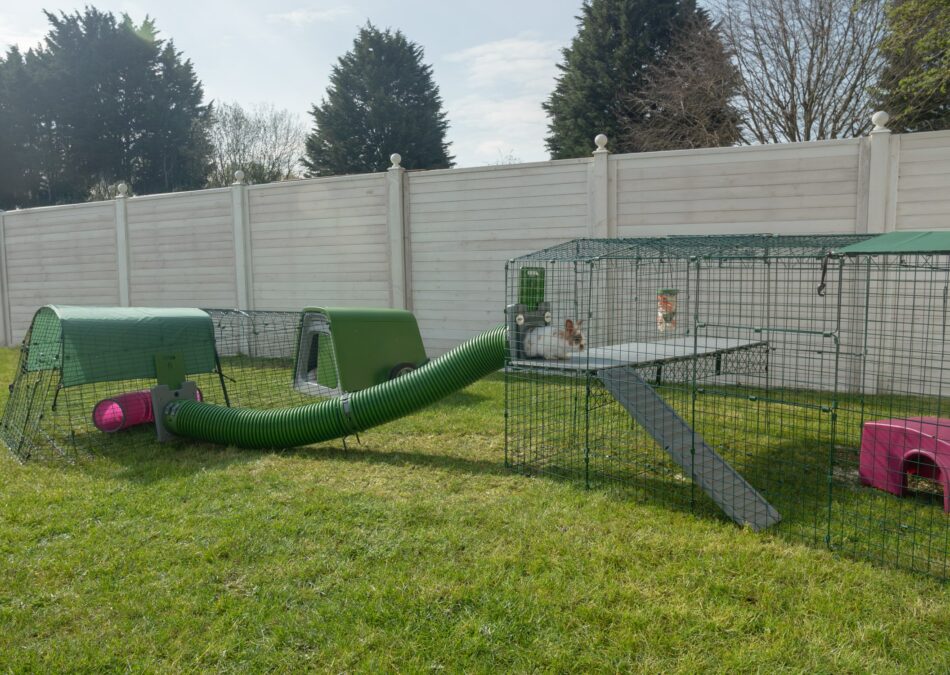
This entry was posted in Rabbits
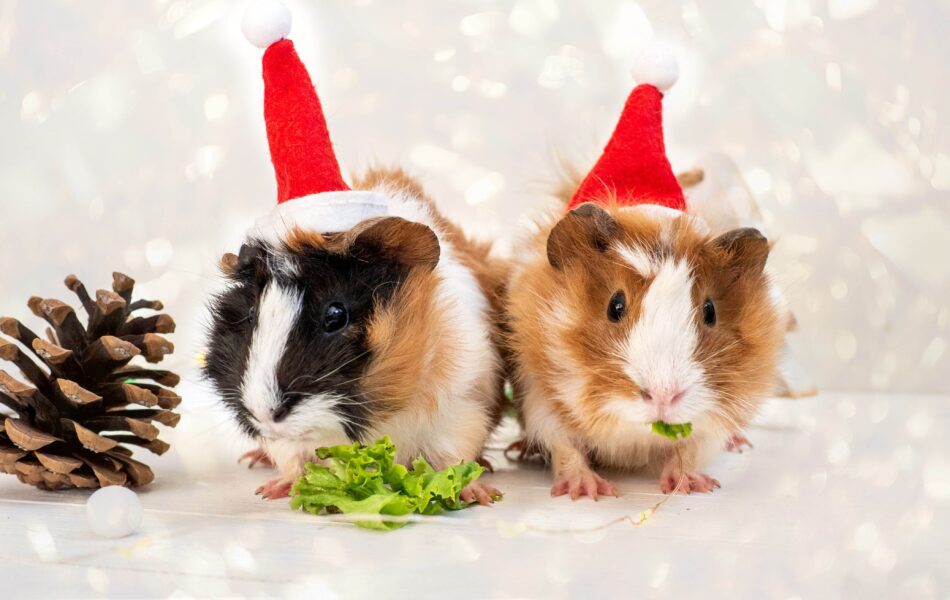
Christmas is the most magical part of the season. It’s the perfect time to snuggle up with your small furry friend and enjoy this special time of year.
And let’s not forget the food. Christmas is one of the biggest holidays for a “foodie,” and if you share a home with a rabbit or guinea pig, you know they’re foodies too. Thankfully, there are several festive treats that you can share with your food-loving friends – just hold the seasoning and spices.
What are your Christmas meal staples? If you’re like most, your Christmas spread probably includes turkey, stuffing, various vegetables, and sides, punctuated with decadent desserts. And with all that meal prep, there are lots of scraps and trimmings that you can give your rabbit or guinea pig as a special holiday treat.
Treats for your bunnies
Rabbits and carrots go together like turkey and gravy. But what other trimmings can you save for your bunny when you’re prepping for your Christmas meal?
Rabbit-safe Christmas meal ingredients that you can share with your bunny include: carrots and their tops (though in moderation, as carrots are high in sugar – which is why rabbits love them), celery, cranberries (fresh or unsweetened and dried), fresh green beans, and leafy greens such as lettuce and cabbage. And if your Christmas dinner doesn’t stick to the traditional menu, a list of rabbit-safe foods can be referenced to see what you can feed your bunny from the kitchen.
The easiest way to keep your rabbit’s treats separate from what gets tossed and what gets seasoned is to keep a bunny bowl on the counter. Any trimmings that are meant for your rabbit can be scooped into a bowl and offered once you’re done with your meal prepping – just make sure all of your helping hands in the kitchen know what this is for.
If you’re really feeling festive, you can also find many recipes online for rabbit-friendly baked goods like carrot cake or banana treats to make their holiday extra special.
Guinea pig goodies
Guinea pigs follow a diet that resembles a rabbit’s, except that they need more vitamin C as they cannot manufacture their own. The same foods that you reserve for your rabbit can be safely offered to your guinea pig, but some additional considerations for cavies are: small amounts of orange or orange peel, bell peppers (yellow, red, or orange are best), broccoli, apple slices, and berries.
Part of the cuteness of cavies is their build, but with their little legs and larger bodies, it’s important not to overfeed them. Ideas for guinea pig baked goods can also be found online, but any holiday goodies should be served as a one-time treat.
Keep a cavy cup handy in the kitchen during holiday baking and meal prep. If possible, refrigerate excess scraps to offer at a later date if your cup “runneth over!”
Holiday hazards
While there are many delicious and nutritious foods to share with your rabbit or guinea pig, there are also holiday staples that should not be shared. Avoid feeding:
- Nuts and seeds
- Potatoes (especially if raw)
- Sugary or baked goods
- Bread
- Meat
If your rabbit or guinea pig happens to sneak a taste of something they shouldn’t, identify what it was and how much they ingested and call your vet. Christmas is the most common time of the year for pets (large and small) to get into something they shouldn’t, so take precautions to ensure your bunny or cavy aren’t able to sneak a bite. Make sure your rabbit or guinea pig is safe in their hutch or run, or set up a rabbit or guinea pig playpen to keep your furry family members out of the kitchen and away from falling foods and cooking utensils.

Special occasion treats and year-round feeding
Rabbits and guinea pigs both need a quality pellet feed (ideally timothy hay-based), and unlimited access to timothy hay or orchard grass and fresh water, with guinea pigs needing additional vitamin C. Around 90% of both your rabbit and guinea pig’s diet should consist of these staples, with treats being given no more than a few times a week.
The best treats are those that incorporate into a well-balanced diet for bunnies and cavies, such as vegetables or fruits that offer nutritional value. Anything indulgent should be offered on special occasions like holidays or your pet’s birthday – otherwise, it might upset their digestive systems or influence their food preferences.
Feeding treats in a Caddi rabbit treat holder or a Caddi guinea pig treat holder is a great way to keep their favourite treats together and up off the ground. It’s also a nice “plating” option when serving up special holiday fare.
A home for the holidays
The holiday season should be a time of comfort and joy for both you and your furry family members. This time of the year also brings colder temperatures and freezing precipitation, so be sure your rabbit or guinea pig is housed in an insulated rabbit hutch or guinea pig hutch for optimum cosiness. And bring on the joy with Zippi tunnels and playpens for endless fun so guinea pigs and rabbits can warm up their bodies and appetites.
With a warm home, full bellies, and loving humans, your small furry family members are sure to have the best holiday season.

This entry was posted in Christmas

What do you think of when you hear the word whisker? You may envision a 5 o’clock shadow on the face of a man, or maybe even a kitchen gadget. But chances are that the first thing that comes to mind is the face of an adorable animal such as a kitten or a rabbit.
We all know that rabbits have whiskers – as children, we learn to draw them onto the faces of our bunny artwork, and that they’re an essential part of any good rabbit costume. But do whiskers serve a practical purpose beyond just adding cute-factor to the muzzles they grace?
Virtually every mammal has whiskers! Whiskers have much more sensitive follicle bases than regular hairs, so while nerves do not run through the whisker itself, they are able to relay sensory input through touch. These naturally-acquired facial accessories serve the same two main functions in all species:
- To sense surroundings in dark conditions
- To serve as a measuring aid when assessing small spaces
So as a pet, does your rabbit still need these capabilities? And as an owner, is there any special care to be taken with these sensitive appendages?
The wonder of whiskers
Your pet rabbit uses their whiskers on a daily basis. In fact, they provide a virtual sixth-sense for your bunny! Rabbits don’t have the same focus or depth-perception to their vision that humans do, so their whiskers provide them with tactile sensory feedback to fill in the missing details. Even when they’re in a familiar space such as their rabbit hutch or rabbit playpen, rabbits utilize their facial “feelers” when it’s too dark to see their surroundings.
Before just bounding into any ol’ burrow, your rabbit uses its whiskers to determine whether or not they’ll fit into a tight space. Even as your rabbit runs through their Zippi Rabbit Tunnels, they’re being felt out by a rabbit’s whiskers to make sure they’ll fit!
And, new studies suggest that like other animals, rabbits are able to tell the texture of an object by vibrating their whiskers against it! Rabbits can also sense vibrations and the movement of air and water with their whiskers.
Rabbits are able to twitch and move their whiskers in an action called “whisking.” While this type of whisking may not produce baked goods, it does bring joy to the observer! Whiskers are also the first points of contact when meeting another rabbit or fellow animal with whiskers – almost like a handshake!
Whisker length and arrangement
A rabbit’s longest whiskers are as long as their bodies are wide on each side! They’re also arranged according to a specific pattern above their eyes, on their nose, and under their chins for a full range of spatial awareness. The whiskers start off shorter by their nose, and get longer in each row going toward their cheeks and tops of their heads.
The whiskers toward the front of their face act as tactile tools for feeling around in the dark, or for sensing objects directly in front of them. Due to the placement of their eyes, rabbits cannot see something that’s directly in front of their nose – they rely on their other senses to perceive what is right in front of them.
The longer whiskers above their eyes look very similar to false eyelashes! Not only does this give them a doe-eyed expression, these longer lashes also keep debris from getting into a rabbit’s eyes.
A rabbit’s longest whiskers are used primarily for gauging spaces, orienting themselves, and feeling for vibrations.
Does my rabbit need a shave?
It’s very important to never cut your rabbit’s whiskers! Since the whisker itself does not have blood or nerve supply, cutting it will not cause pain, but it will interfere with a rabbit’s natural abilities and coordination. Think of it as if you were taking eyeglasses or contact lenses away from someone who is severely near-sighted. They would be able to walk, certainly, but they would stumble, bump into things, second-guess themselves and not move nearly as quickly or efficiently as they did before. If a rabbit were to suddenly lose its whiskers, it would have to re-learn how to interact with its surroundings.
If you were to trim rather than shave the whiskers off at the base, it would relay incorrect information to the rabbit. By trimming the whiskers shorter, they would no longer be as long as the rabbit is wide. Your rabbit may then try to squeeze into spaces they have no business trying to fit into!
Whisker worries
Why are my rabbit’s whiskers falling out?
Just as they do with their coats, rabbits will shed their whiskers in a routine fashion. So, if you find a stray whisker in your rabbit’s environment every once in a while – don’t be alarmed! It’s a perfectly normal process, and soon a new whisker will grow in its place.
Will your rabbit be alright without a whisker? Don’t fret – if your rabbit is down a whisker or two, they likely won’t notice the difference!
What if my rabbit’s whisker is bent?
A bent whisker will either eventually fall off at the break, or fall out as part of the natural shedding process and will regrow as usual. Refrain from trimming the broken part of the whisker yourself because you could accidentally cut or more whiskers in the process!
Why is my rabbit bleeding from the base of a whisker?
If a whisker is pulled or twisted during rough play, it may either fall out completely, or be partially detached at the base. Whiskers are as sensitive as they are because the roots are in a hair follicle with a blood supply. A small amount of blood is normal for the sudden, unexpected removal or loss of a whisker, but if your bunny is bleeding actively, call your veterinarian! Other reasons for concern over a whisker that warrant a call to the veterinarian include:
- Inflamed base of a whisker, with or without swelling
- Oozing blood or yellow fluid from the base of a whisker
- A partially detached whisker that has not fallen out on its own after a couple of days
- Whisker loss beyond normal shedding – this could be losing multiple whiskers all at once, or whiskers not growing back
- Whiskers above the eye that turn inward, causing them to rub against your rabbit’s cornea
Create spatial awareness
Even with the use of super-appendages, rabbits need a space designed to foster and encourage their natural behaviors. Rabbits are very sensitive animals, and their whisker-wielding ways only adds to the amount of stimuli they process.
By providing the optimal environment, you’ll create a space for your rabbits to feel safe when they perceive danger, playful when they feel safe, and relaxed when they feel secure. Our line of rabbit products do exactly that, taking the guesswork out of creating the ideal habitat for your rabbit!
Our products have been thoroughly “whisked” over by hundreds (maybe even thousands!) of rabbits from around the world. And all of the whiskers agree – Omlet has the hutches, play tunnels, shelters, and accessories to keep your rabbit’s sixth sense performing its best.
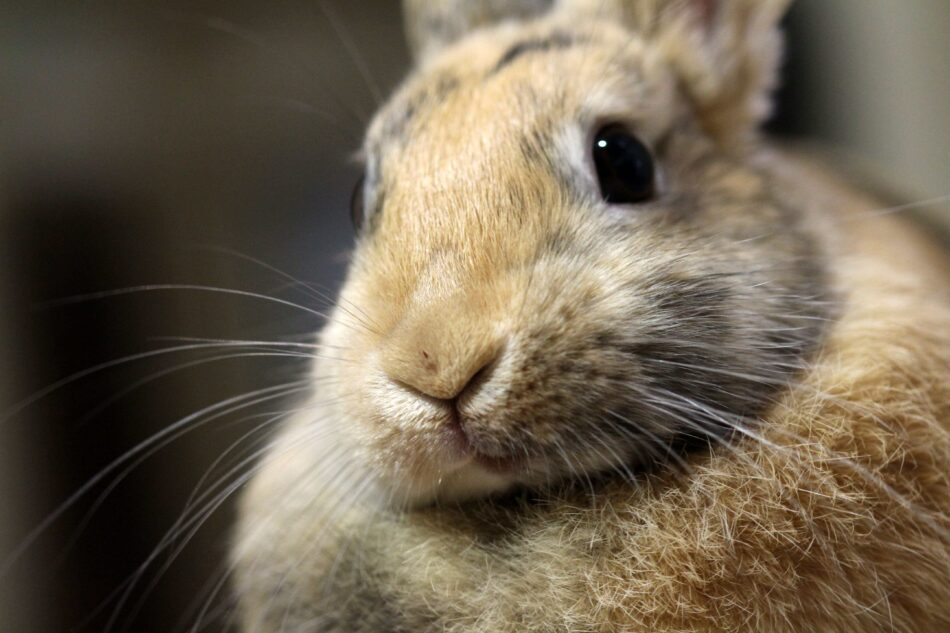
This entry was posted in Rabbits
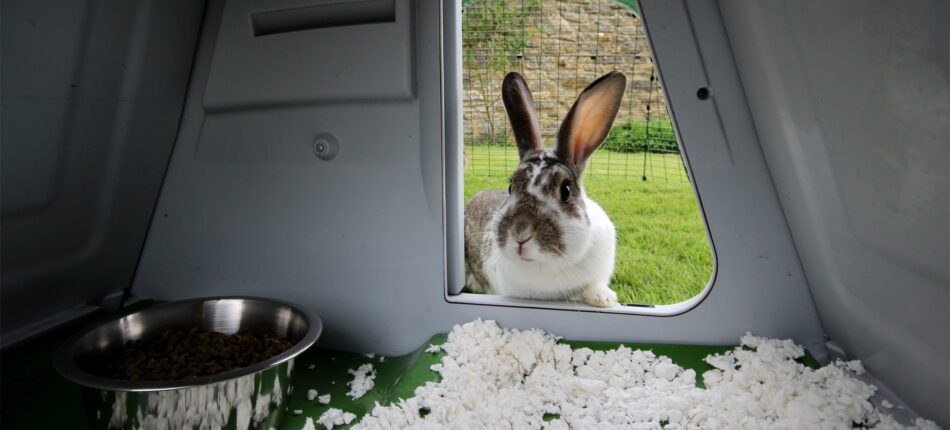
Are you considering adding a rabbit to your family? Or thinking about bringing an outdoor bunny indoor for a season, or even permanently?
Like other small pets, rabbits are very interesting companions to share a home with. They’re easy to care for, build bonds with their families, and don’t require a large amount of space. But unlike other small pets, rabbits are highly adaptable when it comes to their lodging. They can be housed indoors or outdoors, and adapt quickly to a wide variety of environments.
Keeping rabbits indoors allows for closer interaction with them, and also eliminates certain risk factors that come along with outdoor living – such as predators and harsh weather. By keeping your rabbit inside, you’ll also be able to observe their personality and behaviours much more closely. By sharing your living space with your bunny, you won’t have to miss out on a single binky, flop, sprawl, or purr from your furry-family member!
As with any pet, you’ll need to maintain your bunny’s abode to keep it smelling and looking fresh. But with proper placement and cleaning measures, having a pet rabbit indoors can be an aesthetically pleasing and enriching addition to your home!
Boundaries for your bunny
Like small children, bunnies are very curious and don’t always know what’s friend or foe before testing it! It’s very important to take the following rabbit-proofing measures before allowing your bun to explore the inside of your home:
- Make sure your rabbit does not have access to electrical wires such as electronic cables, lamp cords, etc.
- Close off any small spaces that your bunny may try to squeeze into.
- Let everyone in your home know when your rabbit has run of the house to make sure no outside doors get left open.
- Consider blocking off access to wooden furniture that may be enticing to chew on, as treated wood is harmful to rabbits.
For a more exhaustive list of indoor rabbit-proofing, visit: How to Rabbit-Proof Your House.
While you should aim to give your rabbit as much room to stretch their legs outside of their hutch as possible, it’s a good idea to limit your rabbit to specific areas of your home to explore, such as one room or in a rabbit playpen. You’ll be able to keep up with your bunny much easier than if they had free-rein of your house, and having boundaries will make them feel safe and secure.
Litter boxes are not just for cats
Did you know that you can litter box train your rabbit? Like cats, rabbits can be taught to utilize a litter box when nature calls!
Rabbits don’t have quite the instinctive drive to use a litter box as their feline friends, but with a little practice and patience they’ll get the hang of it.
Basic litter box training for rabbits:
- Placement is key! Find where your bunny likes to relieve themselves (usually a corner or other secluded spot) and place their litter box in the exact same location.
- Use some of your rabbit’s eliminations to “bait” the litter box. Pick up some of your bunny’s droppings and empty them on top of the litter. You can also mop up some urine with an unscented tissue or paper towel to place in the litter box.
- Choose a litter box or pan that is an appropriate size for your bunny. If your rabbit uses a corner as their toilet, consider buying a corner-mounted litter box.
- Use a rabbit-appropriate litter (not cat litter!) for your bunny’s litter box.
- Keep your bunny’s litter box in close proximity for the first few weeks. After they get the hang of using it, you can move it to a specific room or keep it in their hutch for them to scurry off to when nature calls!
Be patient when training your rabbit to use a litter box, and expect accidents to happen! For more information on litter box training your rabbit, check out: How to Litter Train Your Rabbit.
When and how often to clean your rabbit’s home
Even if your rabbit is litter box trained, their enclosure will need to be cleaned regularly. Many factors determine how often your bunny’s home needs to be refreshed. Male or female, spayed or neutered, and the size of their enclosure all play a part in how often bedding and hutches will need to be cleaned.
A male rabbit that has not been neutered will have a natural “musky” smell, both from his scent glands and in his urine. Intact male rabbits are also more likely to spray to mark their territory, making eliminations outside of their litter box a regular occurrence (high-sided or enclosed litter boxes are ideal for male rabbits!). Intact females are also known to mark with urine more so than spayed females. However, thanks to their anatomical differences from males, they aren’t quite as messy with their marking!
Use an unscented bedding for your rabbit’s enclosure and litter. While it may sound nice to have a scented bunny enclosure, many added perfumes or scents can be irritating to a rabbit’s sensitive sniffer! Stick with natural odour-absorbing beddings such as recycled paper, pine shavings or pellets, or aspen shavings. Avoid using any bedding that is made from cedar, as the oils can be toxic to your bunny. Straw makes for interesting bedding, but will mould easily once it’s wet, resulting in more frequent changes.
Plastic rabbit hutches are much easier to keep clean than their wooden counterparts, as they do not absorb odours. They’ll also last longer since rabbits nibble on wood to trim their ever-growing teeth! Hutches such as the Eglu Go Rabbit Hutch offer ample ventilation to help air out any stale odours and allow for faster drying times after cleaning.
Rabbit-friendly cleaners
There are many commercially available rabbit-friendly cleaners and sprays that can be used safely around your bunny – just be sure to check the labels for use around rabbits specifically. Sprays formulated with enzymes are great for a quick refresh in the room your rabbit is housed in or in between cleanings – particularly if you have a male rabbit! Simply spray on your bunny’s bedding, litter, or hutch to neutralize odours for up to 24 hours. Again, just be sure to adhere to the manufacturer’s instructions on the bottle!
A quick and easy DIY cleaning solution can be made by mixing equal parts vinegar and warm water for your rabbit’s hutch and accessories. Vinegar is one of the safest and effective cleaning agents for use around bunnies, but if you don’t like the smell of vinegar, this mixture can be diluted even further – up to 1 part vinegar to 10 parts water while still maintaining its cleaning ability. Refrain from adding any “smelly” agents such as essential oils, scent boosters, or other extras to your homemade cleaning solution.
Cleaners to avoid around your bunny
A common additive to cat litter boxes for odour-elimination is baking soda, but it is one of the substances that is toxic to bunnies in large amounts.
Other harmful cleaners or odour-eliminating substances that are hazardous to rabbits include:
- Aerosols, or air fresheners
- Chlorine bleach or ammonia
- Detergents or dishwashing liquid
- Powdered cleaning chemicals
- Floor cleaners, both for hard flooring and carpets
- Wood furniture cleaners and conditioners
It’s important to keep any areas your rabbit may explore free of these substances, including any rooms of your home that they will have access to. Bunnies may try to dig or nibble on carpets, baseboards, or furniture legs, so be sure to either keep them away from these objects, or to only clean your home with rabbit-safe options.
As always, if you suspect your rabbit has ingested or come into contact with a harmful substance, contact your veterinarian right away.
Your rabbit and us
At Omlet, we strive to help you reduce time cleaning and maintaining your rabbit’s area so there’s more time for play! With our extensive line of rabbit products, you’ll find everything you need to make indoor-rabbit ownership easy and enjoyable. Zippi rabbit runs, playpens, and tunnels allow you to customize the ultimate indoor rabbit playground, with plenty of space for them to “binky”, zoom, sprawl, and hop to their heart’s content! Our products are fully customizable to your space and preferences, and can be modified as often as you’d like to keep your rabbit’s space engaging and enriching.
Whether you’re bringing your rabbit indoors for the season, or making a more permanent housing change, we’re here to help! Have questions about transitioning your outdoor rabbit indoors or about products that will help your rabbit adjust to life indoors? Message us below!
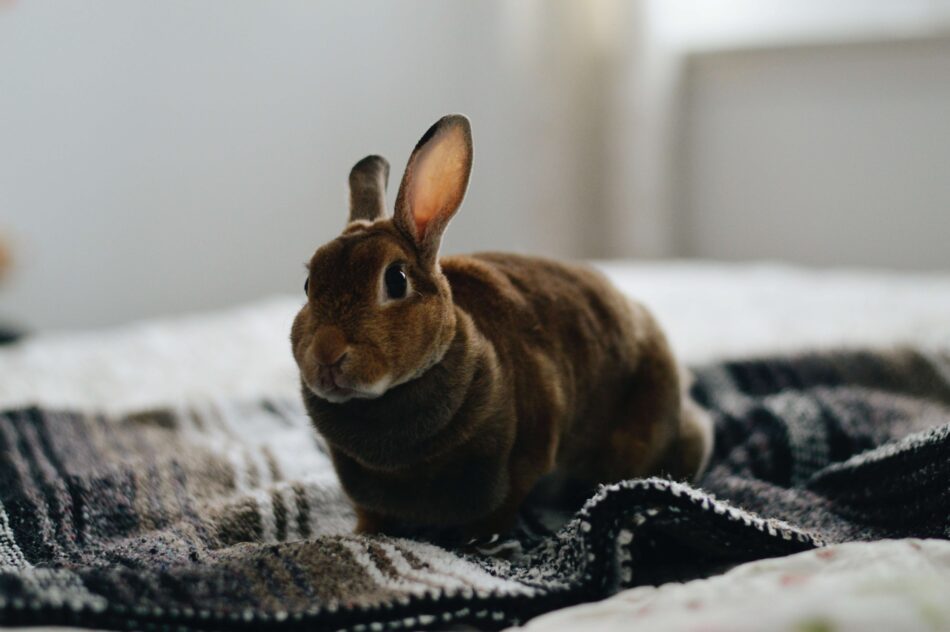
This entry was posted in Rabbits
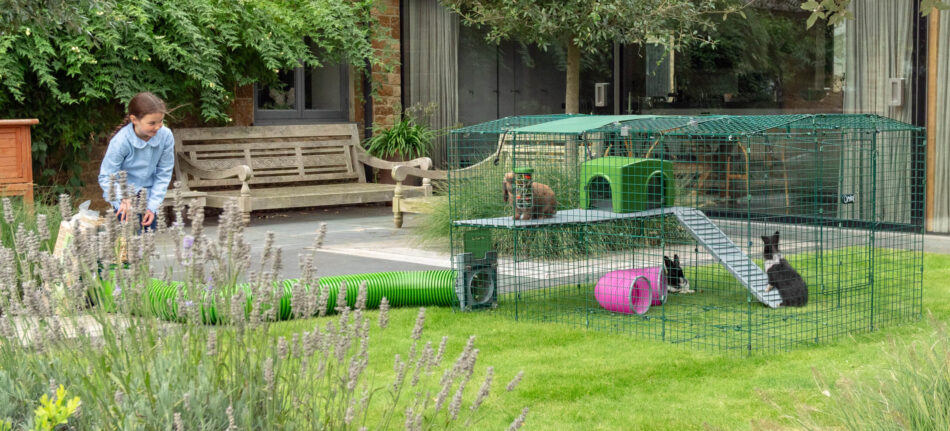
The story of Peter Rabbit by Beatrix Potter paints a fairly bleak picture of a rabbit’s life in a garden. In fact, rabbits earn a bad reputation around the world as garden menaces. Their fast metabolism and curious natures drive rabbits to seek the tastiest and most nutritious vegetation, which inevitably lands them in a predicament much like Peter found himself in! But with a little planning and mindful designing, your garden can be free of the strife that Mr. McGregor experienced!
Our domesticated rabbits have the same instincts as their wild counterparts. In the wild, rabbits live in almost every climate imaginable, and can be found on every continent except Antarctica! This means they have to be able to eat a wide variety of plants to sustain themselves. Wild rabbits are also expert excavators, capable of digging extensive networks of tunnels and burrows. Unfortunately, both of these behaviours can spell bad news for a gardener.
But what if our pet rabbits could live in harmony with our garden plants, just as wild rabbits cohabitate with their native vegetation? What if digging and burrowing could work to the gardener’s advantage while encouraging our pet bunnies to foster their natural instincts?
A rabbit-ready garden
Rabbits are seriously misunderstood as gardening-assistants! If the proper care is taken when designing a garden, pet rabbits can actually be very helpful when tending plants. They’ll trim the ends and edges of plants they are allowed access to, turn the soil through digging and burrowing, and mow stray patches of grass and invasive weeds. As an added bonus, those round bunny poops are actually little nuggets of garden gold! Rabbit manure is one of the best fertilizers for gardens, with many rabbit-keepers saving a stash to add to their compost and natural fertilizers.
But what plants are rabbit-safe? And how much is too much?
Here is a list (which is by no means exhaustive!) of gardening favourites that are both delicious and nutritious for your outdoor bunny:
Garden “Staples”:
- Arugula
- Bell Pepper
- Broccoli (leaves and stems are best)
- Brussel Sprouts
- Carrots and Carrot Tops
- Celery
- Fresh Grass (not clippings!)
- Greens (mustard, turnip, etc.)
- Herbs (basil, cilantro, dill, mint, parsley, rosemary, etc.)
- Lettuce (the darker the variety, the more nutritious!)
- Okra
- Radishes and their leaves
- Squash (summer, zucchini, etc.)
Flowers:
- Asters
- Carnations
- Geraniums
- Hibiscus
- Marigolds
- Nasturtium
- Pansies
- Roses
- Sunflowers
Fruits:
- Apples*
- Apricots*
- Bananas (peel removed)
- Cherries*
- Kiwi
- Mangoes*
- Melons
- Nectarines*
- Papaya
- Peaches*
- Pineapple
- Plums*
- Star Fruit
- Strawberries
* Safe when stems and seeds are removed, as high amounts can be toxic!
Additional ideas for naturally-found rabbit treats can be found here: Forage Treats For Your Rabbit.
As with most tasty things, too much of a good thing can be, well, too much! In order to keep your bunny from overeating (both for their sake and that of the plant!), you’ll need to wrap or surround your plants and shrubs in rabbit-proof mesh to restrict nibbling, or elevate your plants by using planters, plant stands, or raised flower beds. Multi-level gardening can be visually stunning, and your back will thank you when tending to vegetation in raised plant beds!
It’s important to remember that hay (such as timothy or orchard grass) should make up the majority of your pet rabbit’s diet – 75% to be exact! The other 25% of foods offered should be allocated for veggies, pellets, and small amounts of fruit.
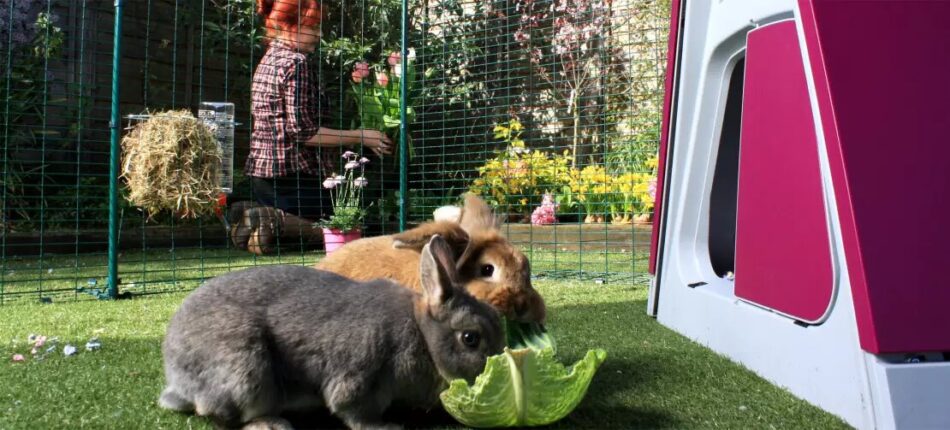
Rabbit red-flags: plants to avoid
Not everything that grows in a garden is safe for your rabbit to consume, and they won’t know the difference between friend and foe when it comes to snacks. Anything plant-like looks appetizing to a rabbit! Take extra care not to plant any of the following where your bunny can accidentally sneak a nibble:
- Azalea
- Blue Bell
- Brugmansia (Angel Trumpet)
- Buttercup
- Christmas Rose
- Columbine
- Daffodil
- Dahlia
- Foxglove
- Hemlock
- Hyacinth
- Iris
- Ivy
- Lupine
- Lily of the Valley
- Milkweed
- Mistletoe
- Narcissus
- Nightshade
- Periwinkle
- Poppy
- Primrose
- Rhododendron
- Tulip
- Wisteria
- Yew
If you are concerned that your rabbit may have gotten a taste of a toxic plant, or is acting ill after consuming any vegetation, be sure to contact your veterinarian right away. It is also helpful to bring a sample of the plant that was ingested, or a picture of the plant in question for your veterinarian to identify.
Rabbit-friendly fertilizers and weed killer
Since rabbits like to dig and burrow in the ground, caution needs to be taken when conditioning your garden’s soil. Commercially bought fertilizers and weed killers contain many substances that are harmful to bunnies, and should be avoided.
Thankfully there are many alternatives to name-brand garden products – and you probably already have the ingredients in your pantry to make them yourself!
The best fertilizer for your garden is made through composting. Compost is super-food for plants, with the added bonus of being super-easy to start and maintain. Made from organic waste such as: food scraps, coffee grounds, dead leaves, grass clippings, weeds, etc., you can start composting as soon as your next meal! Compost piles can be made in a secluded part of your garden, or you can invest in a composting bin. No matter which method you choose, after a small amount of effort you’ll have an easy and nutritious boost for your plants that won’t harm your rabbits!
You can also add individual composting ingredients directly to the soil without waiting for them to break down. Some of the most common soil additives include coffee grounds, egg shells, banana peels, and manure (like what your bunny leaves for you!).
Be sure to exercise caution when adding things like coffee grounds or grass clippings to soil within your bunny’s reach, as ingestion could create digestive upset. It’s best to add actual compost at ground level, and individual ingredients to plants out of your rabbit’s reach.
While rabbits are excellent in helping to clear weeds, some stubborn varieties need a helping hand. This list of DIY weed killers offers rabbit-safe options:
- Vinegar and dish soap
- Rubbing alcohol and water
- Boiling water
Any of these solutions should be applied while your bunny is safely in their hutch to avoid any direct contact. Once the solutions have dried, it will be safe for your rabbit to resume outdoor activities!
Bunny boundaries
No matter how much space you allow your bunny to roam, you’ll need to make sure it’s both escape-proof and predator-resistant.
The Eglu Go Rabbit Hutch is an excellent option for the free-roaming rabbit. It’s compact enough to not take up too much real estate in your garden, and sturdy enough to keep even the most persistent of predators out. Plus, the added run with an integrated no-dig wire floor is an instant outdoor housing solution for your bunny! Incorporate the wire run into your gardening aesthetic by planting rabbit-safe trailing vines, or by placing potted plants alongside the run for easy-access bunny snacks.
If your rabbit roams in a larger space, be sure to have their area covered with wire, or provide lots of plants that offer shade and foliage to hide from flying predators such as hawks and owls. Even if your rabbit is too large to be swept away by a bird of prey, these flying hunters can inflict injury on your bunny by attempting to pick them up. You can also provide escapes with the Zippi Rabbit Tunnel System of your own design, or functional garden decor for safe rabbit-retreats.
To dig or not to dig
Rabbits are diggers by nature. They create tunnels, burrows, or simply move dirt to create a soft and cool spot to settle into on a warm day. When allowed to dig in appropriate places, rabbits fulfill their innate desires and upkeep their physical health – which means happier bunnies and shorter toenails!
It’s important that any rabbit enclosure nestled on the ground have a dig-resistant liner all along the bottom. Even if you forgo having a designated run for your rabbit in favour of free-rein of the garden, all fences should be at least 3 feet tall, with wire-mesh buried at least 6 inches down to prevent escapes. As an added layer of protection, wire-mesh can be fixed to the bottom 6-8 inches of the fence, forming a 90 degree angle with another 6-12 inches tacked into the ground using landscape staples.
Be sure to check your boundary lines daily for any new tunnels that may present a problem. Rabbits are quite proud of their handiwork, and will often spend time in their new constructions, so watch for extending tunnels and burrows. It’s a good idea to mark tunnels to note their progress and to avoid stepping on the hollowed-out ground between an entrance and exit. Plant marking signs make adorable additions to your garden, and can be useful when marking rabbit construction zones!
Any tunnels that aren’t headed in a safe direction should be filled with dirt or gravel to prevent escape. And be sure to watch your step – rabbit tunnel entrances and exits are just the right size to swallow a shoe and turn an ankle! For more ideas on housing your bunny outside, check out: Rabbit-Proofing the Garden.
If allowing your rabbit to tunnel is not a safe or desirable activity for them, creating a network of Zippi Rabbit Tunnel System components is a fun and safe way to curb their tunneling cravings! By connecting Zippi Rabbit Runs and Playpens together, and adding physically and mentally challenging components such as Zippi Lookout Towers or Zippi Rabbit Run Platforms, your rabbit will be able to fulfil its frolicking needs!
Weather considerations
Rabbits are naturally equipped to handle a wide variety of weather conditions, but a little help from their humans goes a long way! If you are transitioning an indoor rabbit to staying outdoors, be sure to take temperature into consideration and avoid excessively warm or cool days at first. The ideal temperature for a rabbit is between 13°C and 21°C, so aiming for days with mild temperatures will give your rabbit the smoothest transition possible.
Of course not every day will have ideal temperatures, but after getting acclimated to life outside, your rabbit’s coat and instincts will adapt to the weather. But to give them an advantage, rabbit weather protection and rabbit rabbit run covers can bolster your bunny’s natural defences against the elements. Rabbits have a dense coat that will insulate them once they are accustomed to being outdoors in winter months, but an insulated hutch is a particularly good idea if you live in an area that experiences sub-freezing temperatures.
Rabbits fare better in cold temperatures than hot, so if you live in an area with excessive summer temperatures, be sure to keep a close eye on the thermometer as well as your bunny. Signs of rabbit heat stroke include:
- Rapid breathing or panting
- Drooling
- Lethargy
Bring your rabbit inside and contact your veterinarian right away if you suspect heat-related illness. Frozen water bottles or ice packs placed near your bunny’s favourite resting spot is one of the best ways to stave off overheating. Your bunny will appreciate having something cool to snuggle up to!
Omlet for the outdoors
At Omlet, we want your pets to live their most natural lives in the safest way possible. Our line of rabbit products are designed to allow your bunny to enjoy the great outdoors without compromising their security. Whether you have a background garden for your rabbit to prune, or keep them housed in a hutch/run combo with strategically placed herbs and edible plants to nibble on through the wire, we have the products to create the ultimate outdoor play space! Easy to set up, clean, and maintain, you’ll love your rabbit’s new setup almost as much as they will!
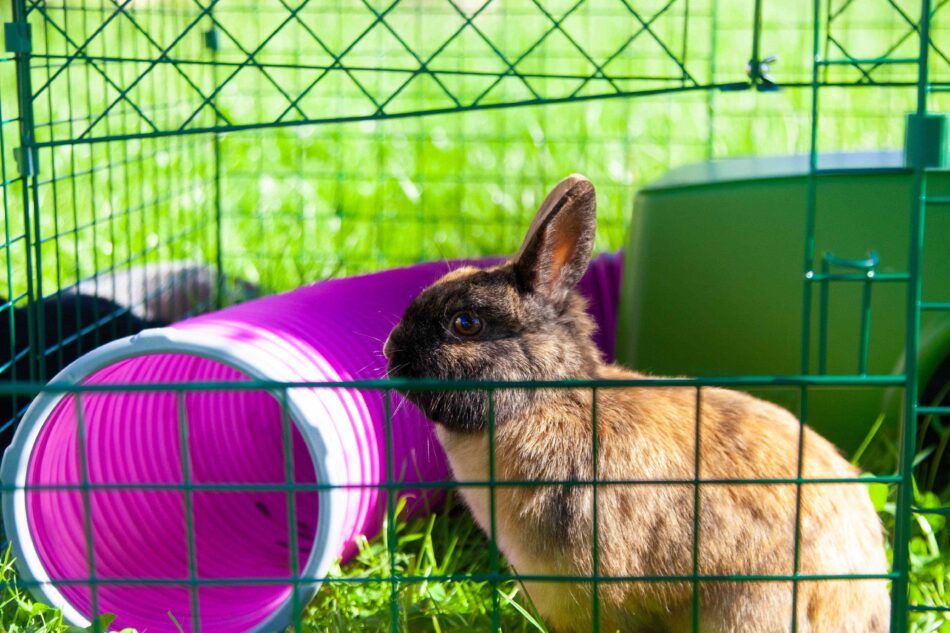
This entry was posted in Rabbits
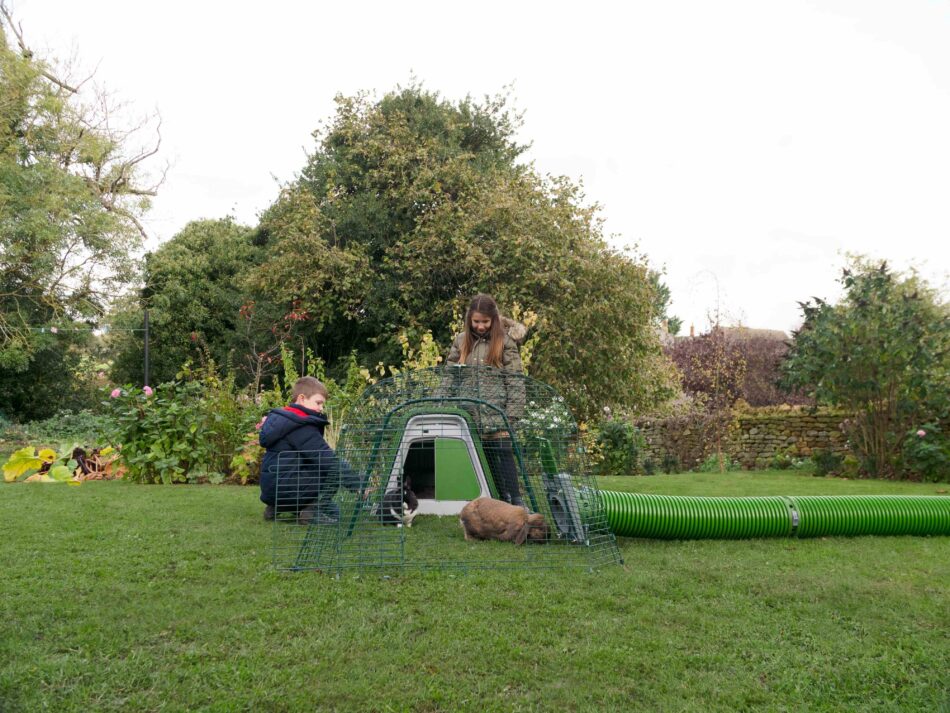
Winter is highly anticipated by some, and a source of apprehension for others. Depending on where you live, your outdoor rabbit could fall into either category! Rabbits that live in states that experience long, hot summers look forward to winter with glee. The good news is that rabbits are naturally able to handle the cold better than excessive heat, and with a helping hand from their human, they’ll be ready to withstand the cold winter months.
Your pet rabbit’s wild counterparts have multiple ways of managing their wellbeing in the cold. For instance, rabbits have a burrowing instinct, as the underground is more insulated and temperature-regulated than the outside air and at the mercy of the weather. But since burrowing down in the ground all winter isn’t an option for most domesticated rabbits, we’ve created rabbit hutches and accessories at Omlet to simulate the ideal conditions for your rabbit to withstand wild weather of all varieties!
With a few minor adjustments to your rabbit’s diet and routine, along with products designed by Omlet to keep the weather out and the warmth in, your rabbit can spend the winter months in their element – safe from the elements!
Cold-natured
Rabbits have dense coats that insulate them from both heat and cold. In the summertime, you’ll notice your rabbit “blowing” their coat frequently in an effort to release their dense undercoat in favour of the longer “guard hairs” on top. As the days shorten and grow colder, outdoor rabbits will shed less and grow out their insulating undercoat once again in preparation for winter. You’ll notice your bunny looking particularly poofy by the time cold weather sets in!
Once they’ve donned their winter coats (courtesy of nature!), bunnies are right at home in the cold! Like their wild counterparts, most pet rabbits will appear more energetic and playful in the colder months. But their increased activity isn’t just out of joy for the season – it’s also to create more energy and heat to warm themselves up. Nevertheless, it’s fun to watch pet rabbits increase their body temperatures through zoomies, hopping, binkies, and social play!
Multiple factors such as breed, size, housing conditions, and age need to be taken into consideration when determining how cold is too cold for your rabbit. As a general rule, most rabbits should be comfortable in temperatures above freezing. Once the weather hits 32℉, it’s time to evaluate how your bunny is faring.
For more frequently asked questions regarding keeping your pet rabbit outside during the winter, visit: Will My Rabbits Be Ok Outside in the Winter?
Blizzards and bunnies
Rabbits don’t mind a little snow, but if you’re in an area that experiences hard frosts and blizzard conditions, you’ll need to bolster your bunny’s shelter!
One of the best ways to keep your outdoor rabbit warm is to mimic their natural tactics in the wild. Bunnies burrow, nest, and huddle together for warmth – all of which you can recreate for your pet rabbit. Insulation, both in the wild and in your backyard, is a rabbit’s best friend in the cold.
Think of your rabbit’s hutch as their burrow. At Omlet, we’ve invented all of our rabbit products to maintain ideal temperatures and conditions for rabbits – just like they seek out in the wild. By selecting a well designed home for your bunny, such as the Eglu Go Rabbit Hutch, they will have an insulated hideaway from the cold that provides ample ventilation without sacrificing warmth. But unlike a bunny-engineered burrow, the Eglu Go Rabbit Hutch is waterproof and predator-resistant for when critters come lurking.
For frigid cold snaps, an Extreme Temperature Blanket is an excellent added layer of insulation for your rabbit’s hutch. Like any good insulation, the material won’t become waterlogged when the snow begins to melt, and traps extra heat underneath to further warm the hutch.
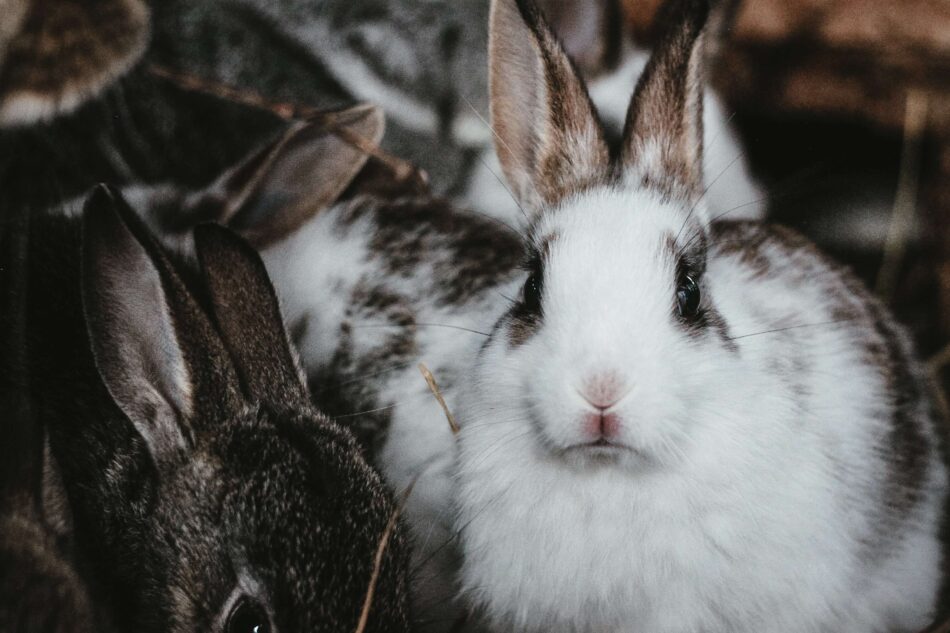
Wild winter weather
The winter season is unpredictable at best, and downright wild at its worst! Cold fronts can come out of nowhere, bringing temperature drops and heavy sleet or snow.
Rabbits, being the intuitive and sensitive animals that they are, can sense when a storm is coming. They can sense atmospheric pressure changes, which will drive them to seek shelter and hunker down. When seeking shelter, rabbits will choose the closest cover available. By placing a few Zippi Rabbit Shelters in their run, you can make sure your rabbit has ample opportunity to escape from the elements.
But you can also create a silver-lining to those winter storm clouds by creating a winter wonderland play-scape for your bunnies! By using a combination of Zippi Rabbit Tunnels, Zippi Rabbit Platforms, and Zippi Rabbit Shelters, you can design a winter-friendly playground that will make your bunny binky with joy!
Health and dietary considerations for winter
Rabbits need different care in the cold months vs the warmer months. You’ll want to inspect your rabbit’s coat before the first cold snap of the season. Check to make sure their undercoat is thick and healthy, and that they don’t have any patches where their hair has not grown in fully (rabbits may have bare or thinned patches of fur from rubbing, playing with each other, or from nervous grooming habits).
Make sure all water bottles or crocks are either insulated or heated to prevent freezing. Heating water on the stove or in the microwave several times a day to add to your rabbit’s watering device is another way of keeping their water thawed and palatable.
Rabbits also ramp up their metabolisms in the winter, and they’ll need more calories to support and maintain their increase in body temperature. They may pass on a hot cup of tea or cocoa, but your rabbit will thank you for extra hay and hay-based pellets during cold weather! You can give treats as usual, but additional treats aren’t necessary. Thanks to their unique digestive system, rabbits benefit the most from foods high in fibre – the longer it takes to digest, the more heat gets generated. Timothy hay, orchard grass, oat hay, and meadow hay are all energy-lending options that should be available at all times to your rabbit. Pelleted feed made primarily from hay should be free-fed as well. If you’re feeding your rabbit a blend (feed that has coloured pellets, cracked corn, or seeds) once or twice a day, you’ll want to transition to feeding a pellet feed before the winter. You can save their blended feed for a special treat to be given in small amounts a few times a week!
It’s important to remember that rabbits do not hibernate. In fact, they become even more active during the colder months! If you notice your rabbit acting lethargic or sluggish, bring them inside and contact your veterinarian. An underactive bunny in the winter is either too cold, or will become too cold very quickly!
It’s all in the design
Preparation is the best method for caring for your rabbit in the cold months. But wouldn’t it be nice to have rabbit-housing solutions that work not only in the cold, but also in the heat?
We don’t want you to have to swap out setups every time the seasons change! That’s why we’ve invented one-product-suits-all solutions for caring for and enjoying your pets.
The Eglu Go Rabbit Hutch was designed to keep your rabbit’s thermostat at an even level all year long. And, with an added Extreme Temperature Blanket, you’ll give your bunny the highest level of comfort possible to not only endure the winter months, but to enjoy them!
And don’t forget that while creating a happy winter-home is important for your rabbit, playtime doesn’t have to fall to the wayside just because it’s chilly! An Outdoor Rabbit Run gives you plenty of space to create a fun playground for your rabbit that you can walk in and enjoy with them!
No matter where you spend your winter, Omlet is here to help you and your rabbit enjoy this season together. Whatever the weather – from temperate to frigid- we’ve thought up the products to cover your rabbit from every angle!
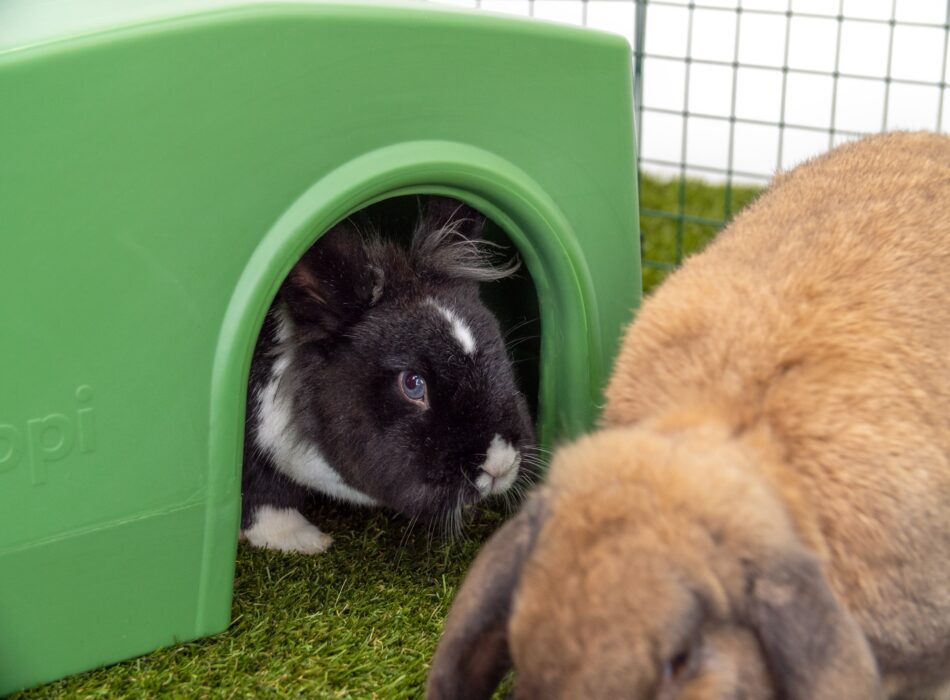
This entry was posted in Rabbits

Bunnies were built to bounce, and in their natural habitat can even reach a super speedy 45mph! Whilst your domesticated floppy-eared pets don’t move as quickly as their friends in the wild, they still need to be provided with an exercise routine. We’re not talking rabbit aerobics or bunny boot camp, but by expanding their living space, you can help your bunnies to stay physically and mentally stimulated. Unsure of how you can offer your rabbits more room to stretch their legs? Let’s hop to it!
Run rabbit run
Your gym bunnies need space to keep on top of their workout routine! Whilst a good hutch like the Eglu Go Rabbit Hutch is great for keeping your rabbits protected from backyard predators and the elements, providing them with an outdoor rabbit run offers them the additional space they desire.
You can extend your Omlet Outdoor Rabbit Run at any time should you need to create even more room for your active rabbits. It has a full height stable door, meaning easy access for you to interact and bond with your bunnies.
Alternatively, add a run up to 13ft to your Eglu Go Rabbit Hutch, perfect for children to get up close to their pet in the backyard. And since evidence suggests that rabbits that bond with their owners live longer and happier lives, enjoying quality time with your bunnies is even more important than once thought.
What if you could give your rabbits the warren their instincts demand with no digging in the backyard? Our product designers once thought the same, which is why we made the Zippi Rabbit Tunnel System! Simply attach the tunnel to your hutch and provide your rabbits with a safe and secure route to their exercise space whenever they want!
Hop on in!
If your bunnies live inside all year round, or you’re considering moving your rabbits indoors for the winter, then a playpen is ideal. Whilst bunny-proofing your home is a given for those keeping indoor rabbits, allowing them free range of the house at all times isn’t always an option. The solution? An indoor rabbit playpen! Fencing off an area with a large indoor rabbit playpen is ideal for creating more space for your pets for those times when they’re not wandering through the house, whilst you can be assured they are in a safe, confined area. You can also accessorize your indoor run using Omlet’s play tunnels – designed by our genius product designers to mimic their natural instinct to burrow!
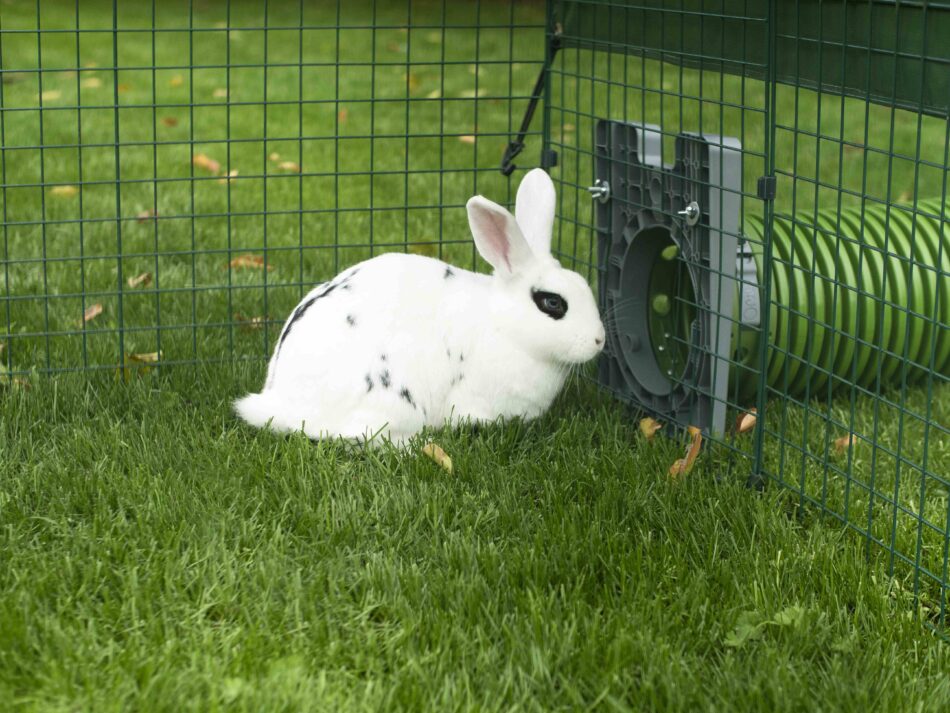
Upgrade to a 2-storey apartment
What if your rabbits could see the world from our perspective? Rabbits significantly benefit from having an additional floor in their enclosure, so upgrading their home, and creating vertical space for your bunnies will give them a new outlook on the world. And now that you’ll almost be face to face with your rabbits, platforms allow you to interact with your pets at an even closer level! Use Omlet’s Zippi Rabbit Platforms in your rabbits’ run to give them their own bunny adventure playground – perfect for pets who live in a smaller space. Platforms are also great for strengthening your rabbits’ muscles. A fit bunny is a happy bunny, and just like us, exercise is fantastic for improving their mental well-being. Since these animals are nervous by nature, a regular fitness routine helps to take the edge off, as well as being a brilliant boredom buster.
Creating more space for your rabbits is one key to successfully having your bunnies live hop-pily ever after! After more advice on enriching your rabbits’ environment? Take a read of our How to Make Your Rabbit Happy blog.
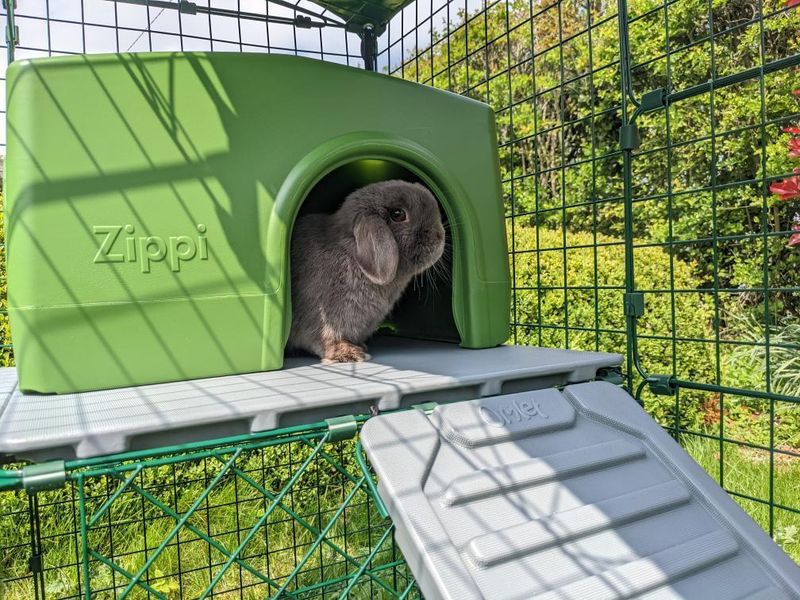
This entry was posted in Rabbits
One of the most commonly asked questions from pet parents of smaller breeds of animals is whether or not rabbits and guinea pigs can live together. They are both small, cute and cuddly, live in hutches (or a super stylish Eglu Go Rabbit Hutch!) and like vegetables but that is pretty much where the similarities end.
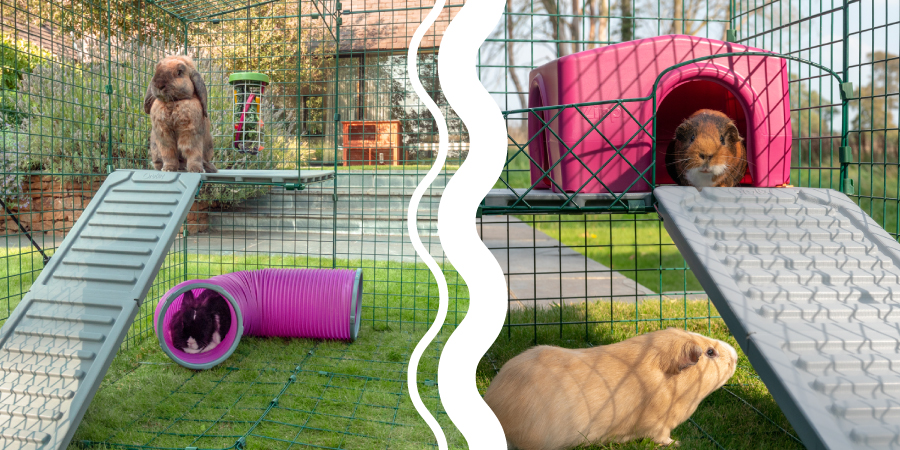
It used to be fairly standard practice for Guineas and Bunnies to live together, this was because neutering smaller animals wasn’t seen as a safe option. Things have most definitely changed since then and this is no longer a concern. The other reason behind this cohabitation is that the saying “breeding like rabbits” is very true! It was thought that by keeping guinea pigs and rabbits together it would prevent mass breeding.
A rabbit’s reproductive cycle is pretty fast, almost immediately after giving birth they can conceive again, and even though the average litter size is 5, it could be even higher! The largest recorded rabbit litter is 24, born to two New Zealand rabbits!
So, if a plethora of bunnies is not for you then your option would have been to let them share the living space with a guinea pig. It’s company after all, right? Wrong, in an ideal world, it would be perfect, however, it is not always meant to be.
Rabbits and Guinea Pigs are not really recommended to share their living quarters. Here, we look into the reasons behind why this seemingly suitable match made in heaven and lifelong friendship, won’t always be ideal.
They have different diets
Many consider these small pets to be similar in many ways, however, their dietary needs are quite different. Even though both mammals require hay, vegetables and fruit for a balanced diet there is something fundamentally different about how they process their vitamin intake.
Guinea pigs need Vitamin C to ensure they have a healthy diet because just like humans, they are unable to synthesise the vitamin alone, due to a gene deficiency. Vitamin C is found in citric fruits and is necessary for survival. Rabbits, on the other hand, can synthesise this particular vitamin, and if they are given too much then it could make them sick.
Housing them together and allowing them to share a food bowl, may only be meeting the needs of one, which could cause health problems down the line for the other.
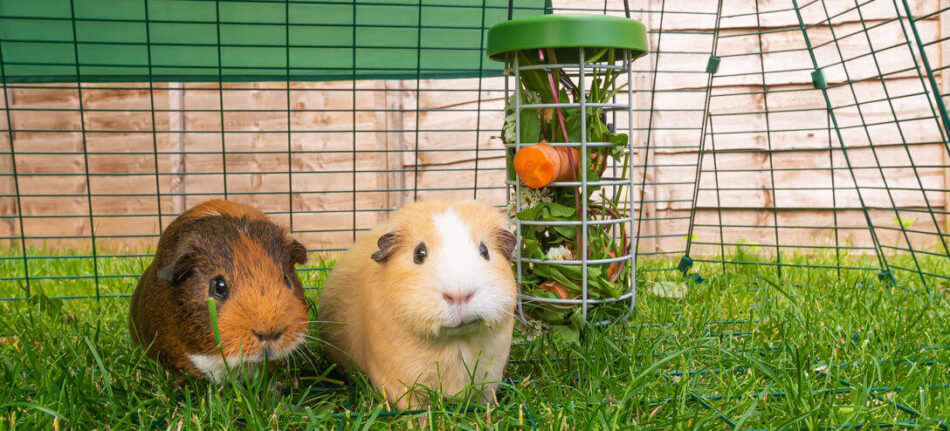
Rabbits bully guinea pigs
This may seem like a bold statement, but it is a possibility and one to be wary of. Our floppy-eared friends are bigger and somewhat stronger than their smaller counterparts. When it comes to food, especially if they are sharing, Peter Rabbit could quite easily push little Mini Guinea out of the way and assert their authority over them. This would result in a tempestuous relationship, especially if your guinea pig is being deprived of food!
Rabbits also love to bounce and hop around as they are very energetic creatures, so playtime could be slightly one-sided and maybe a little rough for your guinea pig who is a little more docile.
They communicate differently
Picture this, you’ve got your feet up, you’re comfortable and have a cup of tea on the side and are ready to read the Sunday papers, and all of a sudden your housemate decides to throw a Hawaiian themed party and invite the whole neighbourhood. That’s a little bit like living with a rabbit (from the perspective of a guinea pig!). Despite both being quite sociable little creatures, guineas do like their own space and time to relax, whereas rabbits tend to thrive from attention, either from regular mating or huddling together with their companions, grooming each other. This type of behaviour can be quite stressful for a guinea pig.
They are a different species after all and will not speak the same language. If they cannot communicate with each other then they could suffer from boredom and loneliness. Whereas if there are lots of rabbits and guinea pigs they will feel happier being with their own kind.
There are health risks
Both animals can be affected by Bordetella bronchiseptica which is a bacterial infection that can lead to bronchitis. It is more severe for guinea pigs, whereas rabbits display very few symptoms.
Another potential threat is Pasteurella which is passed through saliva, for example biting. Again, this is less of a threat to rabbits but more dangerous to guinea pigs. If rabbits and guinea pigs are living together, it could cause health risks which could be detrimental to a safe environment.

How to keep them safe if they do live together
Despite the recommendation that rabbits and guinea pigs should not house share, there may be some exceptions. Introducing them to each other when they are kittens and pups means they may grow to love one another and see each other as friends, not foes. Bringing in a new guinea pig into an environment with an older bunny could lead to a hierarchical imbalance.
You might find that they share a bond or have become the best of friends, or you simply can’t house them separately. If that is the case then there are ways you can accommodate their differences.
Create a safe space for your guinea pig
If your guinea pig needs to retreat for a moment or two then having its own space is so important. Omlet has created products that can be extended, interconnected and upgraded providing you with a simple solution when it comes to creating a unique space for your animals. Start with the Eglu Go Guinea Pig hutch which is super easy to assemble and clean. It provides that perfectly safe peaceful space for your guinea pig!
Feed your pets separately
Rather than sharing a food bowl, which we have discovered could be problematic, feed your guinea pig separately from your rabbit. Consider having a different area to feed your rabbit, like in their own enclosure.
Ensure your rabbit is neutered
Nowadays neutering small pets has become a lot safer and far more common, so it would be recommended if you plan to keep multiple rabbits or keep them with guinea pigs. Since we know that rabbits have the urge to mate constantly, this would not only be annoying for your guinea pig but it could also lead to back injuries, considering they are smaller in stature in comparison to a rabbit. By neutering your rabbit they will have less of a desire to mount their hutch-buddy!
Friendly neighbours?
Of course, there is no reason why you can’t have rabbits or guinea pigs. It is possible to create separate living areas so that they can sleep apart and have space for themselves (guinea pigs mostly), and an extensive play area (rabbits!) to keep them energised and entertained. To improve on this architectural masterpiece, provide them with a communal playpen, with an interconnecting tunnel system.
It’s not as though they can’t live together, it is possible, though it is not recommended and hopefully this article has provided enough information as to why. If you have experience of rabbits and guinea pigs living in harmony together or perhaps not, then please share your stories in the comments section below.
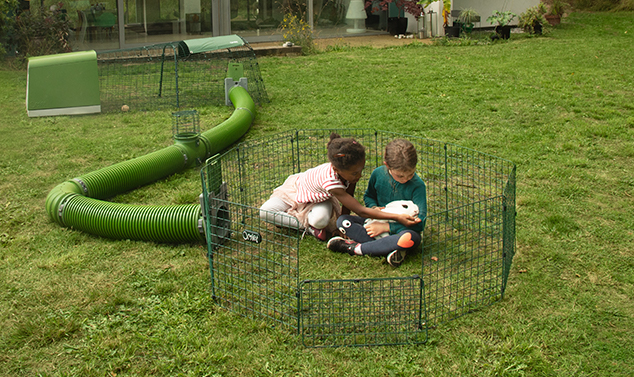
This entry was posted in Guinea Pigs

Is your rabbit a happy bunny? Of course, any pet parent only wants their beloved furry friend to be happy and healthy, so how exactly can you fulfil your rabbit’s needs? Here are our top tips for how to make your rabbit happy!
Good Diet and Fresh Water
First and foremost to ensure your rabbit is happy, they’ll need a good, balanced diet and a constant supply of fresh water. Just as we feel our best when we’re eating well and staying hydrated, so do our pet rabbits! In fact, a large cause of illness in these animals can be traced back to dangerous or wrongly proportioned feeding.
Therefore, a rabbit’s diet should consist of around 80% high-quality hay, and they should always have an unlimited supply available to them. However, hay alone will not provide your pet with all of the nutrients they require. They should also then be given pellet food with ideally a 20-25% fibre content. Muesli style foods should be avoided when choosing a feed for your pet rabbit. This can unfortunately lead to complications with a rabbit’s digestive system and cause issues with a rabbit’s ever-growing teeth. Take a look at Omlet’s range of rabbit food to help you decide what would best suit your rabbit.
Your fluffy friend should also be supplied with greens as part of their diet. However, just be mindful that leafy green vegetables such as spinach, chard and cabbage, whilst nutritious, must be given in moderation. To find out more about the best diet for your rabbit, read our previous blog What Should Rabbits Eat? which will tell you everything your rabbit needs to consume to stay happy and healthy!
Water Bottle or Bowl?
When it comes to giving your rabbits water, there are two options – a bottle or a bowl. Fortunately, Omlet has both to choose from! The rabbit bowls and water bottles section will help you to pick a suitable choice to suit depending on your circumstance. Ultimately, what it comes down to is that giving your rabbit water from a bowl is a more natural way for a rabbit to drink. Bowls, however, can be knocked over and wet your rabbit’s bedding. On the flip side, a water bottle helps to reduce water waste and helps to keep your rabbit’s water supply at one temperature.
Give Your Rabbit Yummy Treats
As well as providing your rabbit with a healthy, balanced diet, giving your rabbit a few yummy treats will go a long way too! Omlet has a wide range of rabbit treats that can be fed to your pet (in moderation of course!). Most rabbits also love fresh vegetables so you can even offer these as a treat too. To find a list of what vegetables are suitable for your rabbit to remain happy and healthy, read our blog Which Fruit and Vegetables Can I Feed my Rabbit? for some further clarification.
Protection From Illness, Injury and Disease
None of us like feeling under the weather, including our floppy-eared friends! Your rabbit’s health is paramount to keeping them happy! It’s important that as a responsible owner, you stay on top of everything they need to protect them from illness, injury and disease.
Omlet stocks a wide range of rabbit health and hygiene products, designed to keep your pet rabbit in tip-top condition or help them recover from minor ailments. The Options Small Animal Mini Grooming Kit is a great rabbit care product, which will not only mean your rabbit’s fur will be looking great, but will also help the both of you to build a bond.
If you are concerned that your rabbit’s normal behaviour has changed, or you suspect they are unwell at all, do not hesitate to take them to their vet.
They Need Somewhere Suitable to Live
There’s no place like home! Rabbits need a secure and suitable place to live, whether you’re keeping a rabbit inside your house, or they are in a hutch like Omlet’s Eglu Go Rabbit Hutch outside. The Eglu Go Rabbit Hutch is a great choice for pet rabbits, perfect for all year round and suitable to house up to two happy rabbits.
Rabbits also of course need rabbit bedding to stay happy! Omlet’s rabbit bedding is suitable for either your Eglu Go Rabbit Hutch or any other bunny home. Dirty bedding increase the chances of them developing horrible conditions such as myiasis, also known as flystrike for a start. Also, your rabbit won’t be happy staying in an unclean environment. In general, these pets like to stay clean and will look after themselves by licking away dirt.
Your Omlet Eglu Go Rabbit Hutch can also easily be extended to offer your rabbit more outside space. Rabbits need to be kept on their toes and with such powerful hind legs that can reach 50 miles per hour, they need space to run! The Omlet Zippi Playpen is ideal for making sure your rabbit has enough room to hop around to their heart’s content, whilst keeping safe. Similarly, the Outdoor Rabbit Run will keep rabbits secure when exploring, and since it’s extendable in width, length and height, it’s suitable for rabbits of all sizes! Find out about all the possibilities of how you can give your rabbits more space with Zippi.
House Rabbits Too!
If you opt to keep domestic rabbits as house pets, then the same applies in that your rabbit’s home still needs to be somewhere they feel safe and comfortable. You’ll need to rabbit proof your home for one, if you do decide to go down this route. This means that you will need to consider all potential hazards e.g. electrical cables, furniture, and house plants to ensure your home is suitable. Furthermore, if you are planning on litter training your rabbit, might want to consider neutering them. Neutered rabbits are a lot easier to litter train. In fact, an unneutered rabbit is almost impossible to litter train completely!
Give Your Rabbit Lots of Attention
Rabbits love attention from their owners once they’re comfortable. And just like any other pet, you should interact with your bunny to continue building a long-lasting bond. You can do this via play, training, or simply speaking to them! Talk to your rabbit in a soft tone, and they’ll soon get used to your voice. You should be able to tell if your rabbit is enjoying your company with a few tell-tale signs that we’ll go into shortly.
Respect Your Rabbit’s Boundaries
As with any animal, it’s important to respect a rabbit’s boundaries to ensure they live a happy life. Whilst rabbits are sociable animals who love showing their owners affection and make for great pets, the average rabbit is also naturally nervous, being prey animals.
One way to respect your rabbit’s boundaries is by reading their body language and responding based on this. For example, a happy rabbit will do ‘the bunny flop’ when they’re feeling happy and relaxed, whereby they will roll on their back with their legs in the air. However, a nose nudge could mean your rabbit wants to be left alone. If you’re new to keeping rabbits, you might be a bit unfamiliar with reading this language. Take a read of our Learn to Read your Rabbit’s Body Language so that you are able to identify when your rabbit is, or isn’t, in the mood to play”
What Noise Do Rabbits Make When They Are Happy?
A rabbit will also communicate vocally to let you know how they’re feeling. The sound of low grunting and grinding of teeth means that the rabbit is content and relaxed. However, if your rabbit lets out a scream, this is their way of telling you that they’re scared or in a lot of pain. As you develop a bond with your bunny, it will become easier to identify how they’re feeling and their likes.
Do Bunnies Like Being Held?
Generally speaking, rabbits do not like being held. Even more so if they have not become accustomed to it from a young age. Therefore, for this reason, some rabbit breeds don’t fit in well with households with small children. This being said, breeds like the French Lops and Dutch Rabbits are renowned for getting on well with young children who will be tempted to touch the new pet! For a bit more breed information on what would work best, read Omlet’s rabbit breed guide.
Create Fun Play Areas
Healthy rabbits need to be kept entertained to remain happy and in the best condition they can be! You can do this by creating lots of fun play areas in their outdoor run space or make your house rabbit happy by introducing accessories to the home. Outdoors, the Zippi Rabbit Playtunnel and Zippi Rabbit Run Platforms are great ways to make sure that your rabbit is mentally stimulated. Platforms also prevent the risk of obesity and injury. Both of this are to be avoided if you want to keep your rabbit happy! Read about more of the benefits of exercise across multiple levels with platforms with our blog Platforms: Benefits of Exercise Across Multiple Levels.
Omlet’s Zippi Rabbit Shelter is also brilliant to add to your rabbit’s environment. Since rabbits have a natural instinct to seek a hidey hole, the Zippi Rabbit Shelter provides this desired protection from the outside elements, as well as being somewhere your pet can sit safely in, whilst observing their surroundings.
Likewise, a Zippi Rabbit Tunnel also encourages a rabbit’s natural instinct to burrow, and a tunnel provides them with a sense of safety and shelter. You can give your bunny rabbits their own warren by connecting their rabbit hutch.
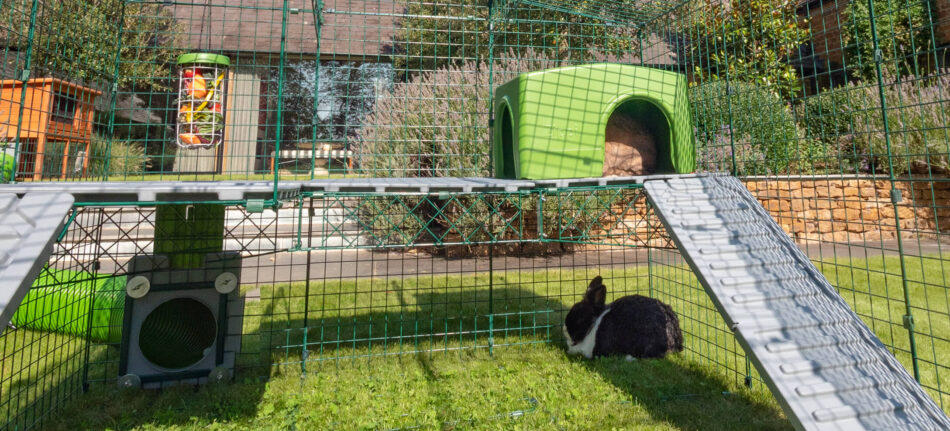
Give Your Rabbit Massages
Did you know that rabbits love massages?! So much so, that rabbits who have regular massages are said to be calmer and less stressed than pet rabbits that don’t! You should always be gentle and move slowly when massaging your rabbit and use a long gliding stroke. Start from down your rabbit’s head, following on to their neck and back. Eventually, end at the top of your rabbit’s tail. It goes without saying that you should gauge how your rabbit is reacting and of course stop if you sense that they’re not relaxed or enjoying the massage. However, if they are, continue to gently massage around their neck and ear base.
Introduce Your Rabbit to a Companion
Whilst your pet rabbit can live a happy life as an ‘only rabbit’, they’ll also appreciate another rabbit friend for them to live with. Getting companion rabbits is a good idea because whilst this desire for having a friend can partially be met with their human pal i.e. you, rabbits can potentially get lonely without a rabbit companion of their own.
Again, because rabbits are a prey species, they enjoy the presence of and find comfort in a friend. One reason for this is because it means not having to look out for predators by themselves. This can then cause a rabbit to be anxious. However, do note that if you do get rabbits of the opposite sex, you will need to spay or neuter them to prevent baby bunnies. There are also other advantages to this, such as reducing the chances of female rabbits developing uterine cancer for example.
Use Positive Reinforcement Training
Whilst training a rabbit might not exactly be the same as training a dog, rabbits do require mental stimulation. Training is a great way of doing this! You can even train a rabbit to do a few tricks like how to give you a high 5! Find out how with this How to Teach Your Guinea Pigs and Rabbits Tricks blog, but the key here is to praise your pet when they’ve demonstrated the behaviour that you have asked for and never to shout at them when they have done something you don’t want.
Give Them a Variety of Toys
Finally, give your rabbit a variety of rabbit toys to play with! There’s a wide range of rabbit toys available, designed to enrich your pets’ environment! As a rabbit owner, it’s your job to find out what your rabbit likes best.
Don’t forget that getting a rabbit is a long term commitment. It’s essential to do your research to ensure you can offer them a fulfilled happy life! If you have a rabbit already, hopefully, after these top tips, you can get the spring back in their step!

This entry was posted in Rabbits
Bringing home any pet is an exciting time for the whole family. But just like any other animal, rabbits require your full dedication and the right tools to make sure that they get off to a great start and live happy and fulfilled lives! So, to help you out, here is our new rabbit checklist, so that you can tick off everything you’ll be needing for your new furry addition.

Hay/Bedding – A Must for Your New Rabbit Checklist
A great place to begin before getting your new pet rabbit is by making sure you have plenty of rabbit hay/bedding. Not only is fresh hay an important part of a rabbit’s diet, but they also require plenty for their bedding. Omlet stocks a large choice of rabbit bedding to tick off your new rabbit checklist – suitable for any rabbit home, including Omlet’s own Eglu Go Rabbit Hutch, to ensure that your new pet gets the comfiest night’s sleep!
Hay is also ideal for encouraging a rabbit’s natural instinct to forage, whereby in the wild, they would search for wild food sources. Foraging also helps to keep rabbits mentally stimulated. You’ll find that a rabbit who is only fed pellets from their food dish, as opposed to a balanced diet including hay, can end up eating too quickly, which can, in turn, make them unwell. Furthermore, a balanced diet for your rabbits will keep their teeth in good condition as well!
Rabbit Food and Bowls
A rabbit’s diet should consist of dry food, fresh food, and hay. Omlet has a wide range of rabbit food that has been carefully selected, offering nutritious and balanced options so that you can pick the right food to suit the needs of your new pet rabbit.
Most rabbits love fruit and vegetables, so it’s a good idea to include these in their diet too. Whilst you might associate rabbits with gnawing away at carrots, this type of vegetable can actually cause constipation in rabbits, and make sugar levels rise dangerously if over consumed. The Caddi Rabbit Treat Holder is the perfect way to feed your rabbits fruit and veg. Not only will it provide your bunny with entertainment, but will benefit you too by improving run cleanliness and reducing food wastage. So if you plan on feeding your rabbit with nature’s very own treats, make sure to read our previous blog Which Fruit and Vegetables Can I Feed my Rabbit? where you can find a list of the fruits and vegetables that are suitable for your furry friend to be fed.
As well as food and an unlimited supply of fresh water, you should also make sure that your rabbit has a food dish alongside either a water bottle or water bowl. Some owners opt to use a bottle over a bowl, but this really is your decision to make. Whilst bowls can easily get knocked over and wet your rabbit’s bedding, they are more of a natural way for a rabbit to drink. This being said, a water bottle reduces water waste and is usually better than a bowl when it comes to keeping your rabbit’s water supply at the same temperature. You can find a selection of rabbit bowls and rabbit water bottles in the Omlet shop.
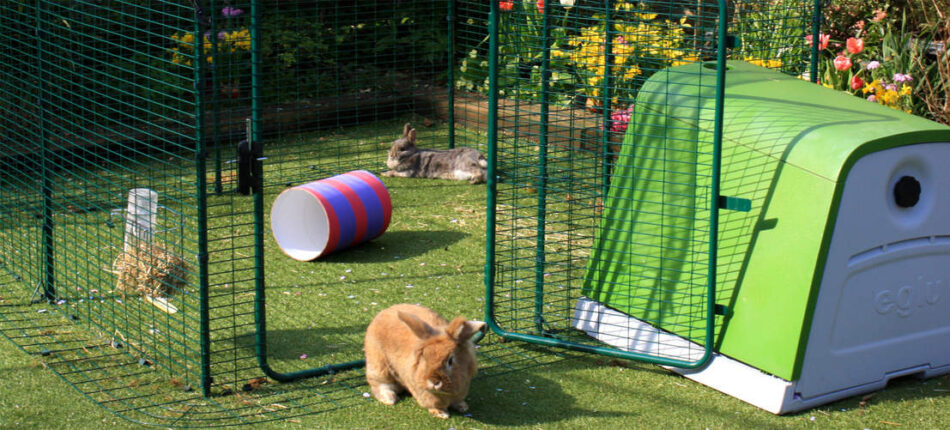
Rabbit Treats
Whilst rabbits need to be fed a healthy diet, the occasional treat won’t go amiss! Treats are a brilliant way of rewarding your rabbit and Omlet’s rabbit treats are perfect for just that! Your new pet rabbit will also absolutely love the Himalayan Salt Lick Stone, which can be hung up in your rabbit’s enclosure and help them to get in essential minerals and salts.
A Rabbit Hutch That’ll Last
Your new rabbit will of course need somewhere to live! Add the Eglu Go Rabbit Hutch to your new rabbit checklist – ideal for any prospective rabbit owner and will keep your bunnies safe from the outside elements and any predators. Even better, the Eglu Go Rabbit Hutch comes with a hay rack, feed bowl and water bottle, making keeping rabbits hassle-free! Furthermore, the Eglu Go Rabbit Hutch has a removable bedding tray, which means you won’t have to purchase a removable litter box for cleaning up after your pet.
If you opt to have a house rabbit, you’ll need to make sure that wherever they stay, they are in a bunny proofed room. You’ll find it helpful to read our guide on How To Rabbit-Proof Your House for some more information on this topic.
New Rabbit Checklist Essential: A Safe and Secure Run!
As well as your rabbits having a hutch or home to live in, they’ll also require a safe and secure run to provide them with some extra freedom and time for hopping around, so this definitely should not be missed off of your new rabbit checklist! One of the leading causes as to why rabbits dig, therefore potentially escaping from their run, is because of boredom. We wrote about this topic on our previous blog Rabbits and Digging if you’d like to find out more information on this area.
Fortunately, the Omlet Walk in Rabbit Run not only offers plenty of room for your rabbit to hop to its heart’s content but will also keep them secure and safe from any other pets or predators. The run has a stable style door, which means that the top and bottom of the door open independently so that you can throw in some treats for your rabbits without the worry of them making an escape! Alternatively, you can create the ultimate rabbit adventure playground with the Omlet Zippi Rabbit Playpen, which can connect to their run and hutch for more space.
Within your rabbit’s run, you’ll want to provide them with plenty of stimulation. Omlet has everything you need to keep your rabbits bouncing around with joy, from the Zippi Playtunnel designed to mimic a rabbit burrow in the wild, to Zippi Rabbit Platforms, that will provide you rabbit new places to explore!
Rabbit Toys
Something else to tick off your new rabbit checklist is toys! Just like our other pets, rabbits need to play, which means they’ll need plenty of toys to enrich their environment and keep their minds ticking! The Omlet Zippi Rabbit Tunnel System connects your rabbit’s run to their hutch but also doubles as a fantastic toy that your rabbit will love. You can also opt for hanging toys that can be attached to your rabbit’s run.
Somewhere to Hide
Your new rabbit will also need somewhere to hide. Although it might sound odd, rabbits actually have a natural instinct to hide in order to stay protected. In the wild, this is done so that they can keep safe from predators such as foxes. Hiding is also a rabbit’s natural response to fear, if they feel stressed, are in pain, are unwell, or just want a break from social contact! Omlet’s Rabbit Zippi Shelter is ideal for rabbits to carry out this behaviour, providing them with a safe space where they can retreat to relax.
Nail Clippers
A rabbit’s nails should not go neglected, so you’ll need to make sure you have nail clippers at the ready! In fact, nail clipping is an essential part of rabbit care, and you’ll need to do so approximately once every two months due to the remarkably quick rate they grow at.
Whilst nail clipping isn’t too long of a process, if you’re not confident doing so, you can always make a visit to the vet and they will be able to give you a helping hand.
New Rabbit Checklist Conclusion
So, whether you’re getting a new baby bunny or rescuing an adult rabbit, hopefully, you will now be prepared for what is to come when your new pet arrives home!
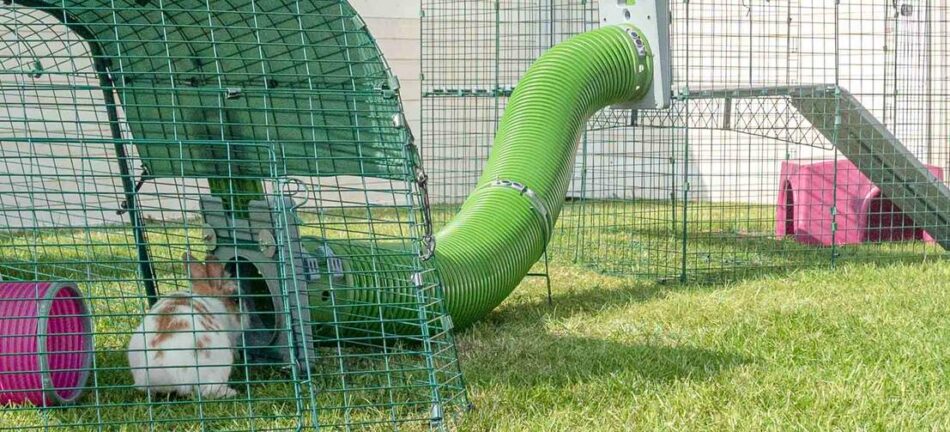
This entry was posted in Rabbits
We all know that dogs have been man’s best friend for centuries, but have you ever thought about friendship with a pet rabbit? Just like dogs, rabbits are highly social animals. This means that they enjoy the company of others, be it of their own species or ours! In fact, evidence even suggests that rabbits who bond with their owners live longer and happier lives! With so much love to give, these sweet natured, fluffy creatures can make for the perfect pets. So, could rabbits be your new best friends?

Why Should I Get a Rabbit?
First and foremost, rabbits are very loving pets and will show their owners affection in a number of ways. So rest assured, you could be on your way to becoming your rabbit’s bestie in no time! If you’re considering getting a rabbit, you’ll grow to learn his or her specific body language. However, generally speaking, a rabbit that loves their owner will display this by purring, running around your feet, or even grooming you!
Putting aside just how irresistibly cute these animals are of course, they’re also incredibly amusing and will provide you with plenty of entertainment. So that your rabbits can become your new best friends, they need plenty of play time with you! Rabbits love playing with a wide array of rabbit toys, which not only helps them keep active, but will provide them with plenty of mental stimulation. And after a hard day’s work of hopping around, you can treat them to a few tasty rabbit treats – the perfect bonding experience!
Rabbits are also particularly appealing to those who would like a furry friend in their life but might not be ready to take on a cat or a dog just yet, that need that extra bit of time being walked or trained. This being said, rabbits still very much require your full dedication as an owner.
What To Consider Before Getting Rabbits
As with taking on the responsibility of any pet, you need to consider whether a rabbit could fit into your lifestyle. Rabbits might not require as much time or training as say a dog would. However, they still do desire companionship and stimulation to live the happy, fulfilled lives they deserve.
Something to consider before getting rabbits is your family dynamic. Although rabbits are commonly associated with being ‘starter pets’, they’re not suitable for young children in some circumstances. This is predominantly for the reason that many rabbits are naturally nervous and don’t like being handled. If your rabbit does have to be picked up, it should be done very gently, which unfortunately doesn’t often go hand in hand with very young children! This being said, some breeds are known to get along well with younger members of the family. The French Lops for example love socialising and won’t mind being handled.
Could Rabbits Be Your Pets’ New Best Friends?
If you’ve also got other pets, this will be something else to think about before bringing home your new addition. Fortunately, many of our other favourite pets do have the ability to get along with rabbits. However, this isn’t to say you should simply put your pets in one room at the same time and leave them be! Instead, slowly introduce your animals in a neural space, with a barrier such as a crate or fence.
If you’re introducing your rabbit to your dog, keep your dog on a lead at all times. Regardless of whether you’re introducing your rabbit to a cat, dog, or chicken, you should never leave them unsupervised during this stage. Keep a close eye on their interaction. You should watch out for whether your rabbit or other fluffy friend acts in an aggressive manner or seems anxious. You can read more about keeping rabbits and chickens together on our previous blog. Do also note however, that rabbits should not be kept with other small animals such as rats or guinea pigs.

Where to Get Rabbits
As with getting any animal, it’s important that rabbits are purchased/rescued from a reputable breeder or centre. Take time to do thorough research. Some rabbit breeds are best suited to owners with a little bit more experience than others.
Because of the misconception that rabbits are ‘easy pets’, there has been a surge in unwanted rabbits in shelters. The National Animal Welfare Trust is an organisation that offers a solution to this crisis. They ask that those interested in rabbit ownership consider fostering for a short period of time. This is so they can ensure that rabbits are being properly taken care of. It’s also so that prospective owners can see if a rabbit will suit your lifestyle before making the commitment. To find more information about the National Animal Welfare Trust, visit their website at www.nawt.org.uk.
If you’re unsure of where to start when it comes to picking what rabbit breed would be best suited to you, take a look at our a-z Rabbit Breed Guide. Once you’ve narrowed your options down, have a read of our How to Choose the Right Rabbit Breed for You blog, so that you can find your match and new best friend! So, could rabbits be your new best friends?
This entry was posted in Rabbits
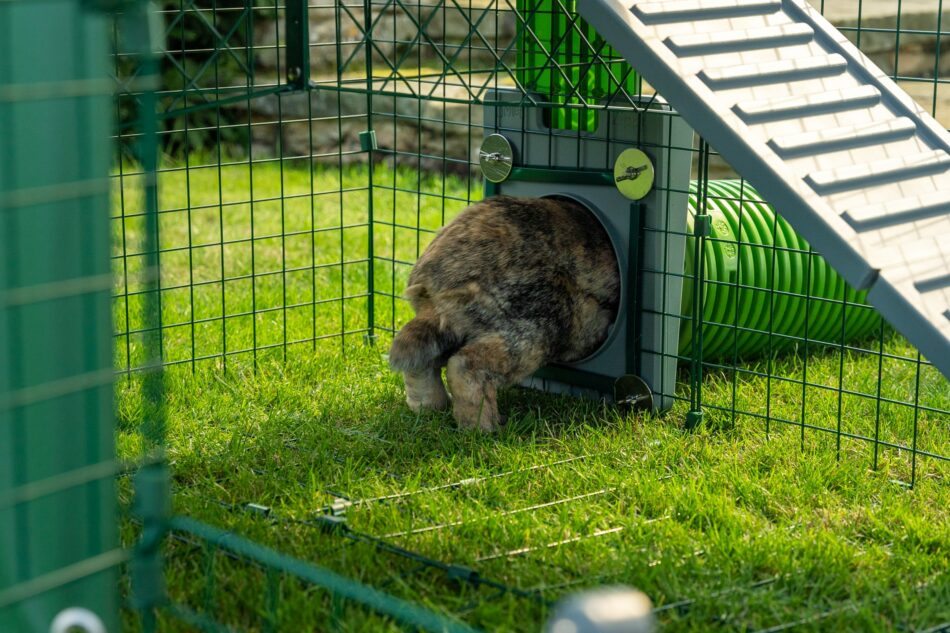
Most people would associate rabbits with carrots, but in reality rabbits and digging go hand in hand. No matter the variety, all rabbits have an innate desire to burrow, tunnel, or scratch in the dirt. But is it out of boredom, fun or just general mischief? Look into the behaviours of our long-eared friends with us, and delve deeper down the rabbit hole to discover why they dig. And, there are some simple Omlet-approved hacks that might just do the trick in helping to curb your bunnies’ burrowing habits.
In the wild
Wild rabbits live in burrows – a network of underground warrens where they feel safe and protected from predators such as foxes and dogs. Digging is a necessity; a matter of survival. Without it, they would be left open to attacks, which is why rabbits have evolved into the tiny excavators that they are today.
Have you ever noticed just how big a rabbit’s paws are? All the better for pounding away at the dirt. And, their long claws are perfect for scraping at the earth. Maintaining their warrens is a big job – requiring these specific tools nature has provided them with.
All rabbits have their own behaviours and personalities, but females tend to be the most determined diggers because they instinctively prepare themselves for nesting. These traits carry over into our domesticated pet bunnies as well.
Fun and exercise
Digging is not just instinctive though, it is an engaging activity that’s also great exercise (think Zumba for rabbits). So rather than trying to eliminate it completely, it’s a good idea to give pet rabbits ways they can utilize this natural behaviour without destroying areas of your home or garden. At Omlet, we’ve developed the Zippi Rabbit Tunnel System, so that our pet bunnies can feel at home and comfortable – all while keeping your garden intact. Rabbit proofing your garden can also help give your bunny space while protecting your prized plants. Zippi tunnels provide an extensive playground of interconnecting tubes that keep rabbits entertained, similar to the burrows their wild ancestors would be used to. It also provides a safe route for your rabbits to navigate from their hutch, to their area, and back again. This method of travel mimics how rabbits in the wild utilize tunnels and burrows between warrens and the outside world.
Change the course of the Zippi tunnels anytime. The tunnels can be extended, rotated, or elevated for a more diverse route. An engaged bunny is a happy bunny, as boredom takes a toll on all rabbits.
Boredom
Constant digging not only wreaks havoc and poses an area of concern to you, but it could also be a sign that your rabbit is bored or lonely. Bunnies are naturally very sociable animals that love company. We strongly recommend giving your rabbit a housemate or two, because they thrive best in a pair or group setting.
If you do only have one rabbit then they will need more attention and entertainment than those who live with other bunnies. Sometimes rabbits can create a strong bond with their owners that is enough to curb any loneliness. Or, other playmates can include guinea pigs, small dogs, or cats – but these are largely dependent on the animals’ individual personalities. Any mixed-species interactions should be monitored closely.
Always offer plenty of enrichment for your rabbits. A Caddi Rabbit Treat Holder will help keep them entertained during snack time. Some rabbits also enjoy small toys like those designed for cats, or those specially made for rabbits.

Space to explore
If you start to notice some aggressive and disruptive behaviour in your rabbits, it could be due to a lack of space. Even as small animals, they can outgrow their living quarters. Rabbits will thrive much more with space and stimulation. The Zippi Rabbit Runs and Playpens provide your rabbits with more room to grow and explore in a safe environment. They’re simple to install, move, and maintain. They’re also easily extendable, offering endless possibilities and fun. Add Zippi Rabbit Platforms to utilize even more space and provide different vantage points.
5 ways to curb your rabbits’ digging
The more idle rabbits are, the more trouble they will cause. Keeping busy generally results in less digging from your rabbits. Provide lots to do to keep your rabbits busy. Here are 5 ways to help your rabbits dig safely, or to discourage digging altogether.
1. Digging boxes
Place a cardboard or plastic box in your rabbits’ area and fill it with soil, paper, twigs, or anything else that will provide a little resistance. Your rabbits can satisfy their urge to dig while also burning some excess energy in the process.
2. Reward
Scatter your rabbits’ favourite treats around a designated “digging spot” to reward their burrowing efforts, and hopefully prevent them from digging elsewhere. It may take some patience and consistency, but over time, they should get used to the new routine.
3. Organising
Indoor and outdoor rabbits enjoy organising. They may not colour-coordinate their closets, but they do like to pull, bite, tug and scratch the materials around them. This is called “bunching”. Not only is this a great source of entertainment, it also keeps them physically and mentally busy. Use some old bath mats, rugs or towels and let them “bunch” as much as they want – which will effectively provide a good distraction from creating a hole in your flowerbed. Be careful with the type of fabric – if anything shreds too easily it could become a choking hazard, so be sure to change the fabric if it becomes too thin or worn.
4. Spaying or neutering
Some rabbits will dig out of frustration and the need to escape and find a mate. Spaying or neutering your rabbits will diminish this impulse and prevent other unwanted behaviours. Like with dogs and cats, in the long run, your rabbits will be healthier and happier being spayed or neutered.
5. Anti-tunnel mesh
The Omlet Eglu Go Rabbit Hutch attached run, is made from a strong steel mesh that helps protect your rabbits from predators. It also comes with an underfloor wire that will not only keep your rabbits from their relentless digging, but will also help stop them from burrowing under the run and escaping. It’s more hygienic than a solid floor, with big enough gaps in the mesh so that it still provides the comfort of grass rather than uncomfortable hard ground or metal.
Omlet: the rabbit behaviourists
At Omlet, we dedicate our time to developing products with the animal and their owners in mind. Our Caddi Rabbit Treat Holder, Zippi Rabbit Tunnel System, and Zippi Rabbit Runs and Platforms are all perfect additions to any bunny-lover’s home, and will help keep your rabbits healthy and happy for years to come.


This entry was posted in Rabbits
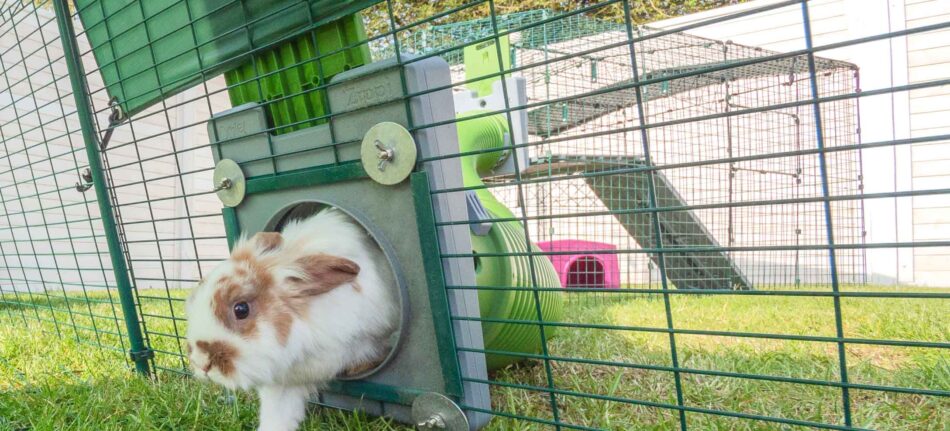
Providing your small pets with enough exercise and activity is extremely important for their mental and physical well-being. An under stimulated rabbit or guinea pig will easily become bored, which can result in unwanted behaviours and a lot of frustration. Luckily, there are things you as an owner can do to encourage movement and introduce more excitement into their lives. Here are some of our top tips:
Provide more space
It might seem obvious, but it’s much easier for a rabbit or guinea pig to get enough exercise if they have plenty of space to move around on. Extend their current small animal run, add new small animal playpens, or set up a room in the house or area of the garden where your pets can securely roam free.
Change things up
New things will excite and stimulate your rabbits and guinea pigs. However, they don’t need a completely new home every month to stay interested. Regularly swapping toys around or changing the setup of their hutch and run by moving accessories to new places will encourage them to explore, stimulating both brain and body!
Get them foraging
Rabbits and guinea pigs instinctively love searching for food. You can help them live out this natural interest by hiding treats in their enclosure, stuffing hay into small nooks or putting leaves, fruit and vegetables in a Caddi Guinea Pig or Rabbit Treat Holder. Anything that gets your pets working for the reward of some really good treats is great in terms of activating them!
Level up
Adding guinea pig and rabbit platforms to your enclosure is a great way of utilising all the space available. Guinea pigs will love running down ramps, and rabbits can use their long leg muscles to jump up onto platforms or steps. As if that wasn’t enough, rabbits especially love sitting up high and inspecting their surroundings, so giving them a lookout space is going to be very popular!

Digging opportunities
While it might not apply to the average guinea pig, you will struggle to find a rabbit that doesn’t absolutely love digging. If you don’t want them to ruin the lawn, giving them a designated digging pit is a good idea. A large plant pot or tray with loose soil will be a great start. You can also put some crumpled up newspaper in the bottom for your rabbit to shred.
Get involved with the playing
If your pet is comfortable with it, a great way of activating them is to play together. Get down to their level and give them some time to get used to your presence. Eventually they will likely approach you and you can slowly introduce games and interactive playing. You can bring toys and treats for encouragement, depending on what your pet likes.
Some rabbits and guinea pigs can also be mentally stimulated by learning tricks. We’ve got a blog on how to train your small pet if you think this might be for you!
Teeth exercise
Rabbits’ and guinea pigs’ teeth never stop growing, so to keep them in tip top shape your pets will need something to grind them down with. A constant supply of hay is the most important thing, but you can also give them gnaw toys and pet friendly branches to nibble on.
Give them a space to rest
While it’s important to give your pets enough space and opportunities to move and exercise, it’s just as important to make sure they have places in their home where they can settle down and relax. Being prey animals, they will benefit from having somewhere secluded to return to where they know they will be safe. This could be snuggling down in the bedding of their rabbit hutch, or peeking out from a guinea pig shelter on the run.
This entry was posted in Guinea Pigs

Whether you’re buying a present for an animal loving child or for your own little pet, we’ve got the perfect gifts, big and small. Check out these top tips, now at an amazing price in the Omlet Black Friday Sale!
Shelters and Play Tunnels
Give your rabbits or guinea pigs something fun to play with on their run this winter with Zippi Guinea Pig Shelters and Rabbit Play Tunnels. Available in green or purple, the shelters are a great way of providing a safe and secluded place for your pets to hide, or as a platform they can jump onto and watch the world go by.
The play tunnels can be placed independently anywhere on the run for your pets to chase each other through, or be connected to the shelters to create a maze that mimics their wild burrows. Entertainment and safe spot in one!
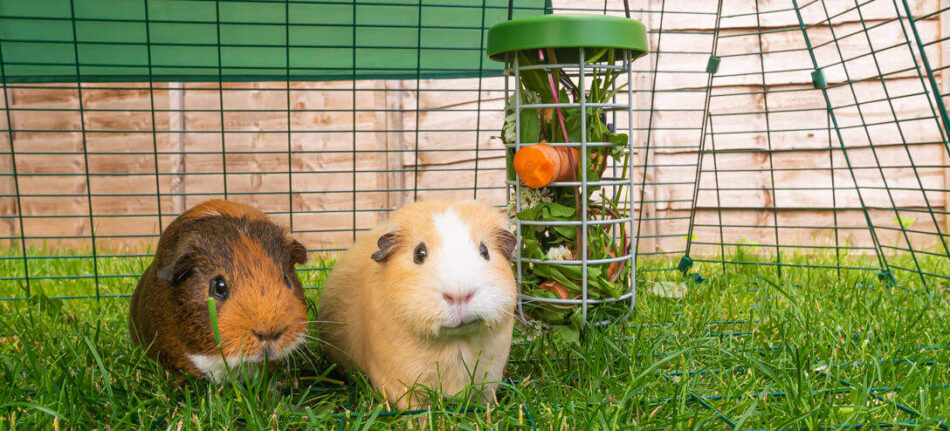
Caddi
The Caddi Rabbit Treat Holder is the perfect stocking filler for chickens, rabbits or guinea pigs, or their owners. The Caddi can be filled with a range of pet appropriate treats, and will swing as the animals peck or bite the treats. It’s the ideal both mental and physical challenge, with the added bonus of a tasty reward!
Hung from the roof of your hutch and run, the height of the Caddi can easily be adjusted, and it’s super easy to remove it for refilling and cleaning.
Qute Hamster and Gerbil Cage
The Qute hamster and gerbil cage allows owners to get closer to their pets. The modern design means you will be happy to display the piece in your kitchen or living room, and the large, crystal clear bedding tray makes it easy for pet owners of all ages to see what their pets are up to. The bedding tray also offers a convenient way of getting your hamster or gerbils out of the cage for playing, socialising and exercise.
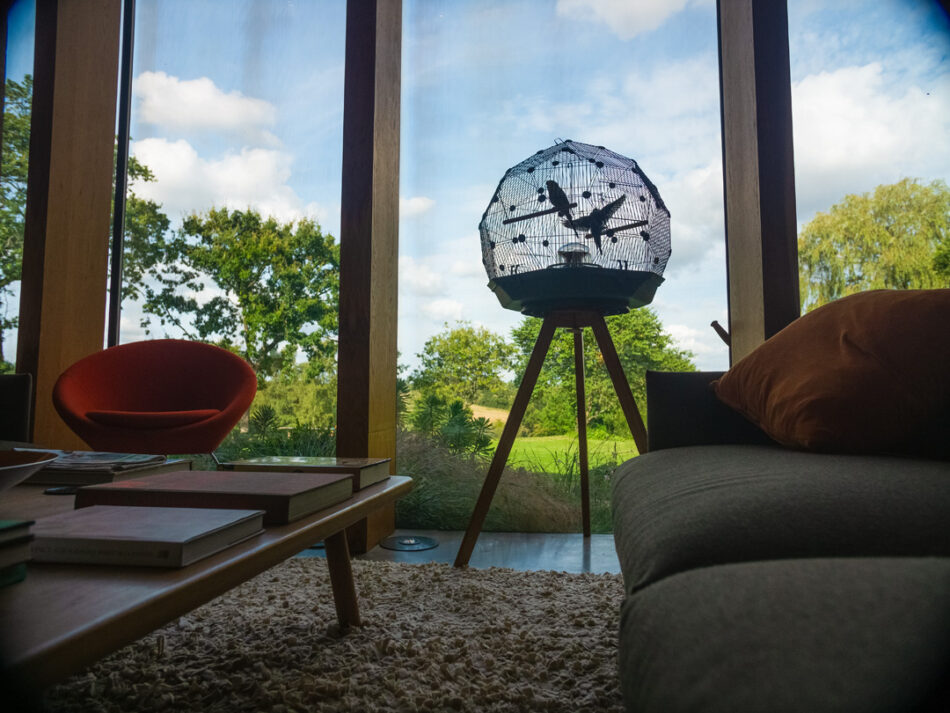
Geo Bird Cage
Upgrade your budgie or other small birds’ home this winter with the stunning Geo Bird Cage. The Geo has got everything your bird needs to become a natural part of the home, and you can accessorise with baths, mirrors and toys for your pets to enjoy.
You can also add a festive touch to the avian housing with the NEW Nordic Green cover. Pop the woodland themed cover with a calming cream background and a trim of geometric trees over the cage at bedtime to let your pets rest in their own winter wonderland.
Eglu Go Hutch
Do your current pets need a home improvement? The Eglu Go Small Animal Hutch is the perfect way of keeping rabbits or guinea pigs in the garden. The handy integrated hutch and run solution allows your pets to run in and out as and when they like during the day, and when it’s time for a nap they can curl up in the safe and insulated house. In winter you can move the hutch closer to the house, making cleaning and spending time with your pets even easier.
This entry was posted in Budgies

Ever cleaned your pets’ run and found old bits of mouldy cabbage or soggy feed that is nearly impossible to pick out of the grass? There is an easy way of keeping your pets’ treats fresh for longer, while also improving run cleanliness AND keeping your animals entertained!
The Caddi can be hung at any height from all pet runs, trees or other structures in your garden. It’s super easy to fill with whatever you want to give your pets, be it bits of fruit, fresh hay or Feldy Chicken Pecker Balls.
At the moment you will get 50% off Caddi Treat Holders for chickens, rabbits and guinea pigs when you sign up to the Omlet newsletter. Take this opportunity to make your pets’ run funner and more hygienic than ever before!
4 reasons Caddi will improve your pets’ run:
All pets will be happier if their living quarters are tidy and clean, but it’s also important for their health that both their coop or hutch and run are kept hygienic. Mouldy food left on the damp ground can make a chicken, rabbit or guinea pig very ill, so having a Caddi to keep it in will make it much easier for you to spot anything that’s gone off, and to remove it in a second.
Food, treats or hay that is left on the ground on the run will go off very quickly, especially at this time of year when temperatures can vary dramatically between day and night and there is likely to be more rainy days. With the Caddi, the treats you leave your pets will keep fresher for longer as they won’t come into contact with the wet ground. They will also be kept dryer thanks to the waterproof top.
The end of summer means that there will be less food available for wild animals like rodents and small birds, and they are likely to approach your garden and your pets’ home in search for tasty morsels. By putting feed, hay or vegetables in the Caddi rather than scattering on the ground, you are making things more difficult for uninvited visitors!
As the treats, veg or hay you are giving your pets are kept contained in one place and won’t get stepped on by muddy feet, they will be crunchier, cleaner and better tasting. As the swinging motion of the Caddi offers stimulation and entertainment, your pets will truly enjoy snacktime!

Buy now and get 50% off when you sign up for the Omlet newsletter!
Terms and conditions:
This promotion is only valid from 28/09/21 – midnight on 03/10/21. Once you have entered your email address on the website you will receive a discount code that can be used at checkout. By entering your email you agree to receive the Omlet Newsletter. You can unsubscribe at any point. This offer is available on single Caddi Treat Holders only. The offer does not apply to Twin Packs, Twin Pack with Peck Toys or packs with Feldy Chicken Pecker Balls. Excludes all other chicken accessories. Offer is limited to 2 Caddis per household. Subject to availability. Omlet ltd. reserves the right to withdraw the offer at any point. Offer cannot be used on delivery, existing discounts or in conjunction with any other offer.
This entry was posted in Chickens
If you have done your research and decided that a rabbit is the pet for you, you now have the task ahead of choosing which rabbit breed you would like to get. There are lots of wonderful breeds to choose from, and they all have their own specific features and characteristics. To help you pick the right rabbit for you and your family, we’ve put together a list of things to think about:
Size
Rabbit breeds differ in size, from small Netherland Dwarfs to large Flemish Giants. Smaller breeds tend to be more skittish and nervous, whereas larger rabbits are generally more gentle and less aggressive.
Larger rabbits will naturally need more food, and more space. But don’t think that small rabbits will be fine with limited space, often littler bunnies run around a lot more as they have more energy.
Child-friendly rabbit breeds
While young children should never be given the main responsibility of looking after a rabbit, if you have children in the family it’s good to find a breed that is generally happy to be touched and handled.
A lot comes down to personality, but there are some breeds that are known to get along well with children, like French Lops and Dutch Rabbits.
Reason for getting a rabbit
Think about why you are getting a rabbit, and what is important to you in a pet. Are you happy to just watch them enjoy themselves in the garden, or would you really like to have a rabbit that is sociable and wants to come to you for cuddles? Would you like to breed for your bunny, or show it off in rabbit shows? Take a read of our New Rabbit Checklist blog so that you have everything you require for when the time comes to pick up your new fluffy friend!
Looks
Rabbits come with various fur lengths, colours, ear types and builds. You probably have an idea of what you would like your pet rabbit to look like, but it’s worth exploring a few different breeds to see what’s out there.
It’s important to remember that different breeds require different amounts of grooming and looking after. Long fur, like that of the Angora rabbits, will for example need brushing daily or a few times a week, so you will need to consider if that is something you will be happy to do.
Meet the rabbit in person
While rabbit breeds have characteristic features and temperaments, a lot also comes down to breeding and personality. If possible, try to go and see the breeder or person you are buying your rabbit from, or the center where you’re adopting from.
If your rabbit is still small, watch how they interact with their surroundings and siblings, and if possible, see what the mother is like. Make sure the rabbit doesn’t have any obvious health problems, and try to get a feel for its temperament. If it’s important for you that the rabbit is happy to be picked up, make sure they have been around humans from the start and have regularly been handled.
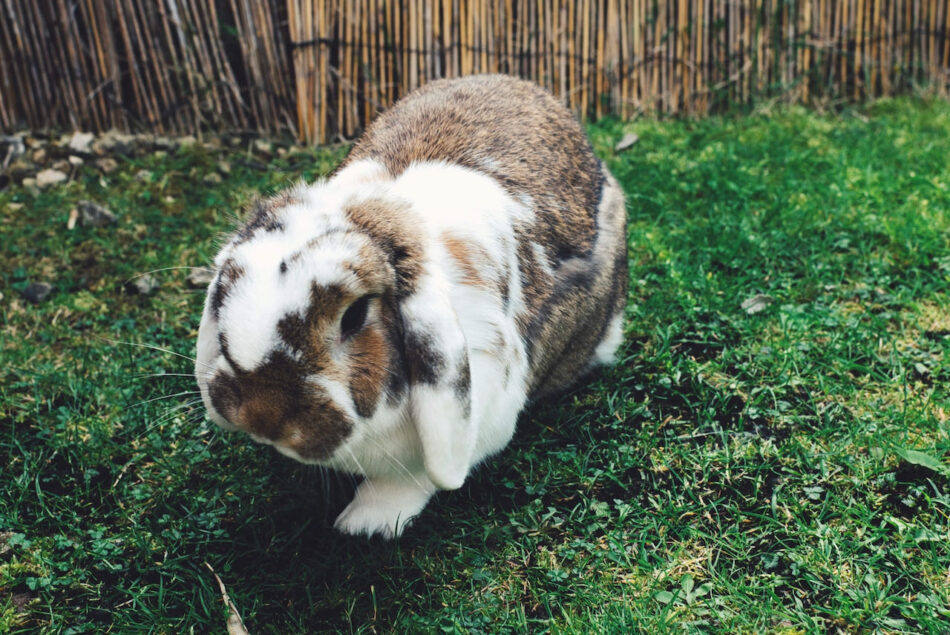
Photo by Cameron Barnes on Unsplash
Genetics
Read up on specific breeds’ susceptibility to different health problems. Some breeds tend to have a higher risk of developing problems with their jaws, others with joints, or ear mites. With good care the absolute majority of rabbits will be happy and healthy, but it’s a good idea to research problems in order to prevent them.
The expected lifespan also differs somewhat between breeds. The majority of rabbits live between 5-8 years, but some breeds are known to often live for over 10 years. This is obviously a bigger commitment, so it’s worth thinking about.
Consider these things when choosing a pet rabbit. If you know what you want, here are some of our suggestions:
You want a gentle family bunny that is good with children
You have had rabbits before and want something special
You want to keep your pet rabbit indoors
You want an intelligent rabbit that is very energetic and playful
You want a really fluffy and cuddly rabbit
This entry was posted in Rabbits

Estimates of the world’s domestic rabbit population vary wildly between 15 million and over 700 million. People have kept rabbits for hundreds of years, and traditionally they were farmed as a plentiful resource – after all, they do breed like rabbits! The larger population estimate includes all the rabbits that are still kept for meat and fur.
With this many rabbit owners around the world, and with the bunny’s rather inscrutable facial expression, it comes as no surprise that the question “is my rabbit happy?” has been asked more than a few times by anxious rabbit keepers.
There are several ways of telling whether your furry friend is content and happy, most of them centring on body language.
Happy bunny body language
Body language is the key way of telling how your rabbit is feeling. Simply by spending time with your bunny, you will learn some of the basic messages that tell you if they are happy and relaxed, or stressed.
These are some of the signs of a rabbit’s mood.
- Twitching nose. Rabbits are constantly twitching their noses. Not only does this help them sniff the air around them, it also eases their breathing, regulates their body temperature and helps them relax. A contented rabbit will do a lot more nose-twitching than a stressed rabbit, so if you notice that your rabbit hasn’t twitched its nose in a while, there may be something distressing it.
- Chilling out. Another easy-to-spot sign of a happy rabbit is an overall relaxed body. Chilled bunnies will lie quietly, ears erect (unless their flop-eared bunnies), sometimes with their legs stretched out, noses twitching contentedly.
- Crouching. Like us, when a rabbit is stressed, its muscles become tense as its fight-or-flight instincts activate and its body floods with adrenaline. If the bunny is in a crouching position, ears flat, pupils dilated, it is anxious, stressed or afraid. The cause could be another pet, a scary noise, or even a whiff of something unfamiliar in the air. This behaviour is common in rabbits who have not been hand-tamed from a young age. Conversely, if your rabbit is chilled out, lounging in the hay and not tensed up in any way, you can be sure that they are content.
- Hopping. When most people picture a rabbit, they imagine a cute creature hopping around. Rabbits have evolved to be great jumpers, with very strong back legs to help propel them at high speeds. Hopping not only acts as a great escape mechanism, it also assists rabbits in their play. Bunnies like to hop around when they are feeling happy and mischievous. Your rabbits may perform the occasional playful leap in their enclosures, jumping in the air, twisting their bodies a little and then landing again, alert and playful. A rabbit showing this type of behaviour is very happy with life. A bunny who is gently hopping around and exploring the world around them is also feeling playful and happy.
- Running. A rabbit who darts for cover, usually stamping its back legs on the ground first, is not a happy bunny. Something has startled your poor pet, and the best thing to do is let it recover its composure and confidence in a safe area – usually a quiet corner of the hutch. A quick run to another spot, with ears flat, can also be a sign of anger.
- Curiosity. Rabbits are naturally nervous and will only let their curiosity take the lead when they feel safe. In the wild, rabbits are at the bottom of the food chain, a source of food for many predators. Because of this, rabbits are naturally jumpy (pun intended) and on edge. Domestic rabbits are calmer than their wild relatives but still retain their natural wariness.
Angry bunny body language
These physical clues tell you that your bunny isn’t chilled or afraid – it’s hopping mad!
- Sitting, front legs raised. If your rabbit sits up, front paws raised and flicking in and out as if trying to punch something, it means the bunny is angry – no matter how cute the behaviour might look! The ears will be erect (although not in flop-eared bunnies) and facing outwards like radars. The posture may be accompanied by a growling sound.
- Crouching and thumping. If your rabbit is tensed up and thumps its back legs on the ground but doesn’t bolt for cover, it’s angry. The tail will be raised and, in stiff-eared breeds, the ears will be erect. Everything about the bunny will look tensed up, and the pupils will be dilated.
- Crouching with bared teeth. If your bunny is crouched with its front legs stretched in front of it and its head up, teeth bared, it’s angry and ready for a fight. The body will be tense, even quivering, and the mouth will be open, the tail raised, pupils dilated and ears folded back.
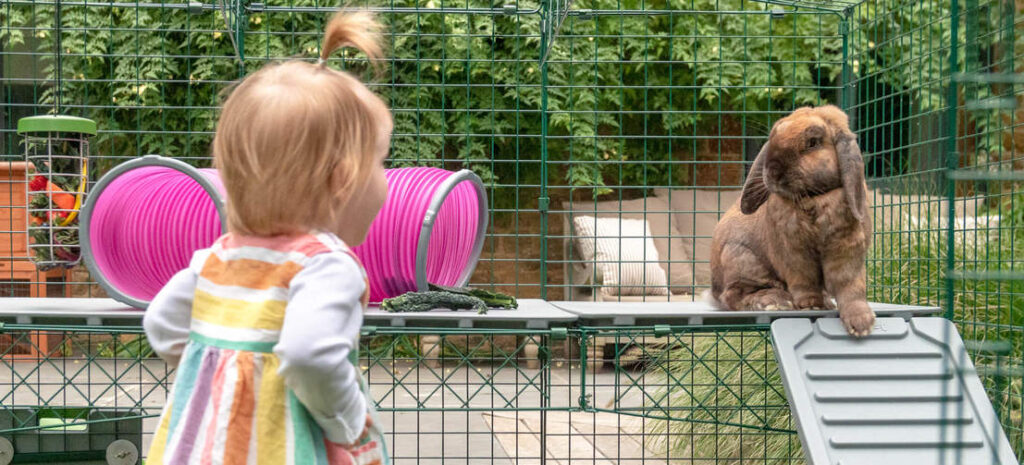
How to make rabbits happy
There are various reasons why a pet bunny might be unhappy or stressed. The commonest cause is poor environment. They need sufficient space in their hutch and run, and they don’t want to be harassed by nosy dogs, cats or loud parties. The rabbits will also need the company and stimulation that enables them to fulfil their natural instincts. Remember – rabbits are social animals and love having other bunnies to play with.
Giving your rabbits regular health check-ups and ensuring they are up to date with their vaccinations is also essential. A healthy diet will go a long way towards ensuring a happy bunny. A high-quality pellet mix and a lot of hay form the basis of healthy diets, with fresh veg as treats.
To summarise, if your rabbit is relaxed around you or shows signs of curiosity rather than fear when introduced to something or someone new, they are almost certainly happy and relaxed.
A chilled-out rabbit is a mixture of nature and nurture. They are naturally skittish animals, but if handled by their owners at an early age, they will come to treat you as part of their safe environment, and their happiness will be obvious in the fact that they love spending time with you.
This entry was posted in Rabbits

Like all social animals, rabbits have a ‘pecking order’. Young rabbits who have grown up together will sort this out without you even noticing. However, if you are introducing rabbits to each other for the first time, they will have to size each other up and establish which one is going to be dominant in the relationship.
The rabbits will not usually sort out this hierarchy by fighting, but display physical behaviour that is the bunny equivalent of two people showing off. They will chase, groom and bow, and one will try to mount the other (a sign of dominance in many mammals).
Why do rabbits groom each other?
On the surface, it may look as if a grooming session is an act of love and friendship. In reality, it is an act of subservience. The bunnies who do the grooming are letting the dominant rabbit know that they accept their place lower down in the social hierarchy. Mutual grooming will sometimes occur, but if a rabbit is licking and grooming another bunny’s ears, eyes and forehead, it means they are acknowledging the dominant rabbit’s place at the top of the pecking order.
The dominant rabbit will often request the grooming by approaching another rabbit and lowering its head. This may look like an act of submission, but it is the exact opposite. The rabbit with the lowered head is saying “here’s my head – get grooming!”
Why do rabbits bow to each other?
A bowing rabbit is asking to be groomed. The dominant bunny will approach its companion head-on, often touching noses. Its ears will be raised, and it will sometimes nudge the other rabbit’s chin to prompt the grooming.
Early in a bunny relationship, before the pecking order has been properly established, the rabbit being bowed to may not take the hint and, instead, will bow back. There will be several bows from each rabbit before the matter is settled, and it may even end in a brief tussle. A rabbit who wants to be groomed tends to insist on it!
Why do rabbits ‘flatten’?
Flattening involves crouching low on the ground, ears down. That latter detail differentiates it from a bow, as the flat ears indicate submissiveness. Rabbits will sometimes perform this action if they feel threatened by another rabbit in the run, and it will usually defuse any potential confrontation straight away.
A dominant rabbit will occasionally approach the ‘flattened’ bunny and lick its forehead. This is an acknowledgement of the submissive gesture, and it means the other bunny can relax.
Why do rabbits chase each other?
Chasing has two meanings. It can be sexual behaviour, with a male chasing a female, or it can be another sign of dominance.
Chasing occurs quite frequently when rabbits are first introduced to each other. When the hierarchy has been sorted out, it becomes far less frequent. However, an unneutered male will often chase habitually to let the other rabbits know he is the dominant one. Some occasional bullies enjoy chasing, too. Unless one particular rabbit is being repeatedly targeted and is becoming stressed, or any individual is hurt as a result of a vigorous chase, you should simply accept it as part of the pecking order.
Sometimes the chase will manifest as a circling motion, with the dominant rabbit literally running rings around the subservient one. This will often culminate in mounting.
Why do non-mating rabbits mount each other?
Dominance is not automatically based on gender, and a female is just as likely to mount a male as vice versa. It’s a bit like wrestling, where the person who has thrown their opponent to the ground has won that particular bout. The rabbit that has been mounted will not always submit after a single mount, and the tables may be turned a few times before the dominance is formally established between the two bunnies.
Once rabbits have settled in together, the mounting will usually end, although some boisterous males seem to persist with the mounting habit. As long as the submissive rabbit accepts this as part of the social setup, it will not lead to further aggression. Occasionally, you might notice the dominant rabbit mounting just to remind the other bunny that they are the boss.
If the submissive rabbit appears to be distressed and is trying to escape, and is being pursued as a result, the animals may have to be separated for a while. Otherwise, it is best to let them get on with it and accept the mounting behaviour as a fact of rabbit life.
Introducing new rabbits
New rabbits should be introduced to each other on neutral territory, if possible. If you simply lock a newcomer in an existing rabbit run, it will be bullied by most of the other bunnies, and the dominant one can sometimes inflict injury on the newbie.
If you can take your dominant rabbit with you when choosing the new pet, it will help enormously. You will be able to see how the old rabbit reacts to the new one, and if all is well, they can even travel home together in the same travel crate. This will also help the bonding process, as both rabbits will feel nervous during the journey.
When you get home, let the rabbits settle down together on neutral territory. If all goes well, they can be moved to the run later in the day, with two food bowls. This is the best-case scenario, and it will often be a more drawn-out process getting two bunnies used to each other. You should have a spare run ready for the newbie rabbit, within sight and smell of the established bunny or bunnies.
Let the rabbits cohabit each day for a few hours on neutral territory until they are completely happy together. This may involve several mounting, chasing, grooming and bowing sessions, but the pecking order will be established in the end!
This entry was posted in Rabbits














































